Huawei's Global Expansion Strategy
VerifiedAdded on 2020/05/11
|20
|5122
|53
AI Summary
This assignment delves into Huawei's global expansion strategy, focusing on its key success factors and competitive advantages. It examines Huawei's market entry strategies in various countries, including the use of VRIN framework analysis to assess its resources and capabilities. The assignment also considers the challenges and opportunities facing Huawei in its international operations.
Contribute Materials
Your contribution can guide someone’s learning journey. Share your
documents today.
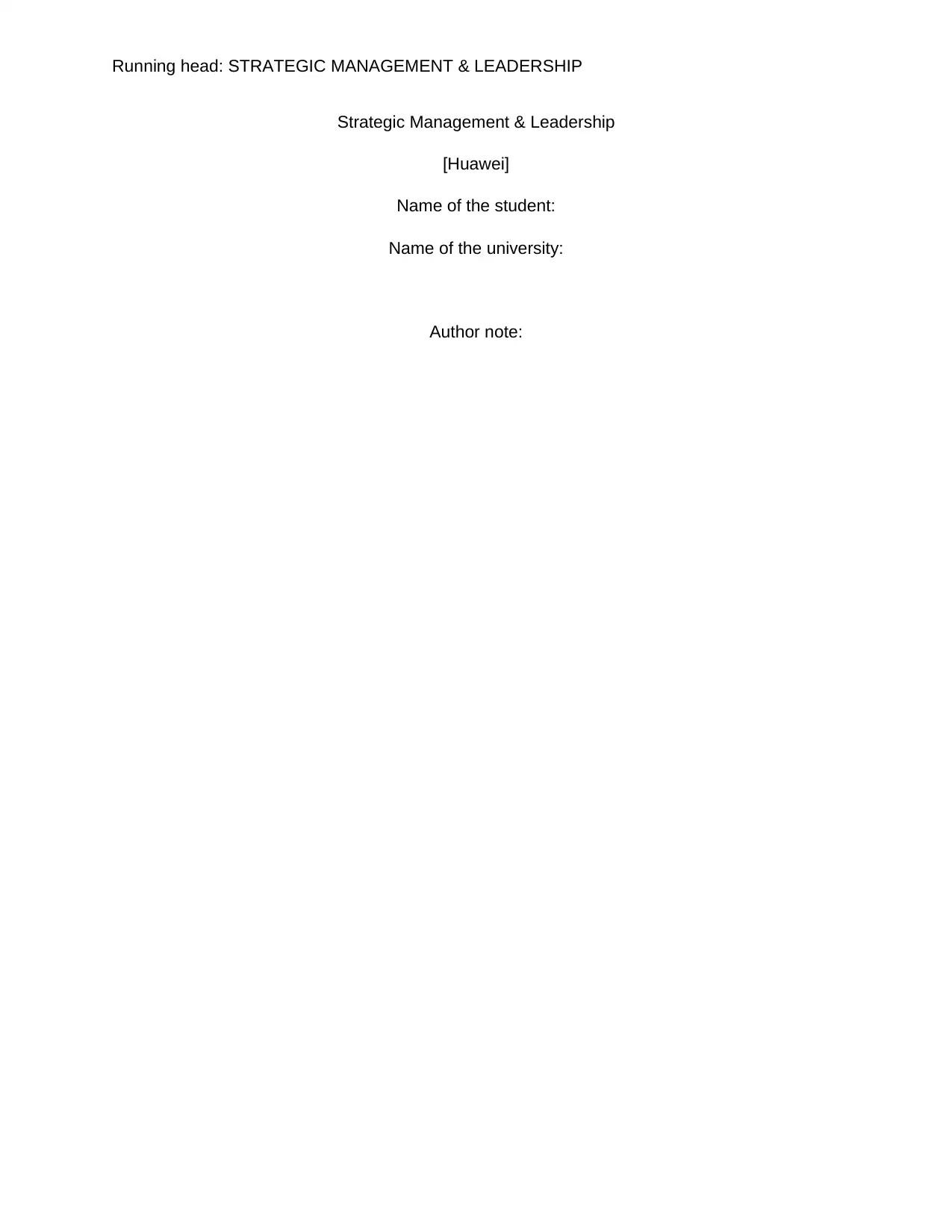
Running head: STRATEGIC MANAGEMENT & LEADERSHIP
Strategic Management & Leadership
[Huawei]
Name of the student:
Name of the university:
Author note:
Strategic Management & Leadership
[Huawei]
Name of the student:
Name of the university:
Author note:
Secure Best Marks with AI Grader
Need help grading? Try our AI Grader for instant feedback on your assignments.
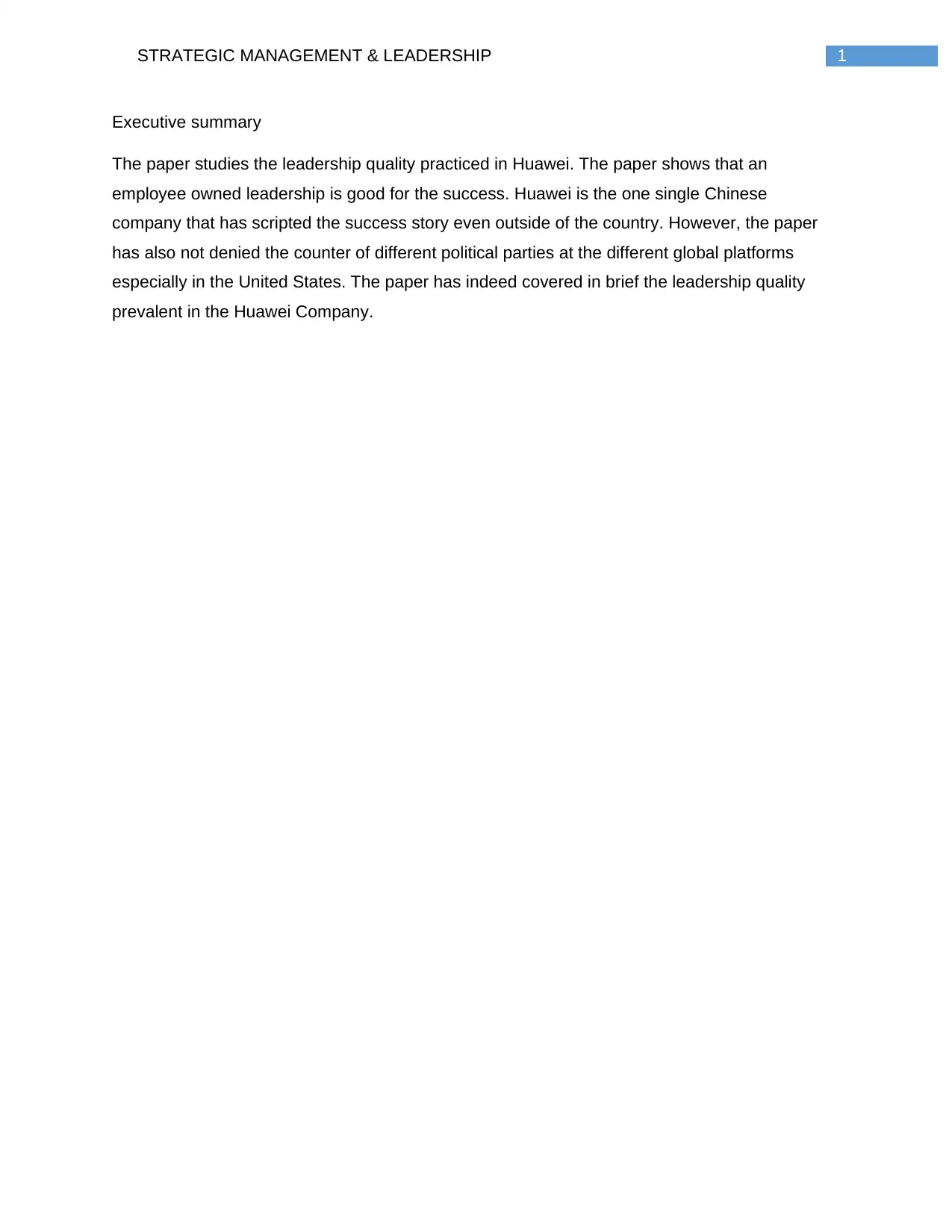
1STRATEGIC MANAGEMENT & LEADERSHIP
Executive summary
The paper studies the leadership quality practiced in Huawei. The paper shows that an
employee owned leadership is good for the success. Huawei is the one single Chinese
company that has scripted the success story even outside of the country. However, the paper
has also not denied the counter of different political parties at the different global platforms
especially in the United States. The paper has indeed covered in brief the leadership quality
prevalent in the Huawei Company.
Executive summary
The paper studies the leadership quality practiced in Huawei. The paper shows that an
employee owned leadership is good for the success. Huawei is the one single Chinese
company that has scripted the success story even outside of the country. However, the paper
has also not denied the counter of different political parties at the different global platforms
especially in the United States. The paper has indeed covered in brief the leadership quality
prevalent in the Huawei Company.
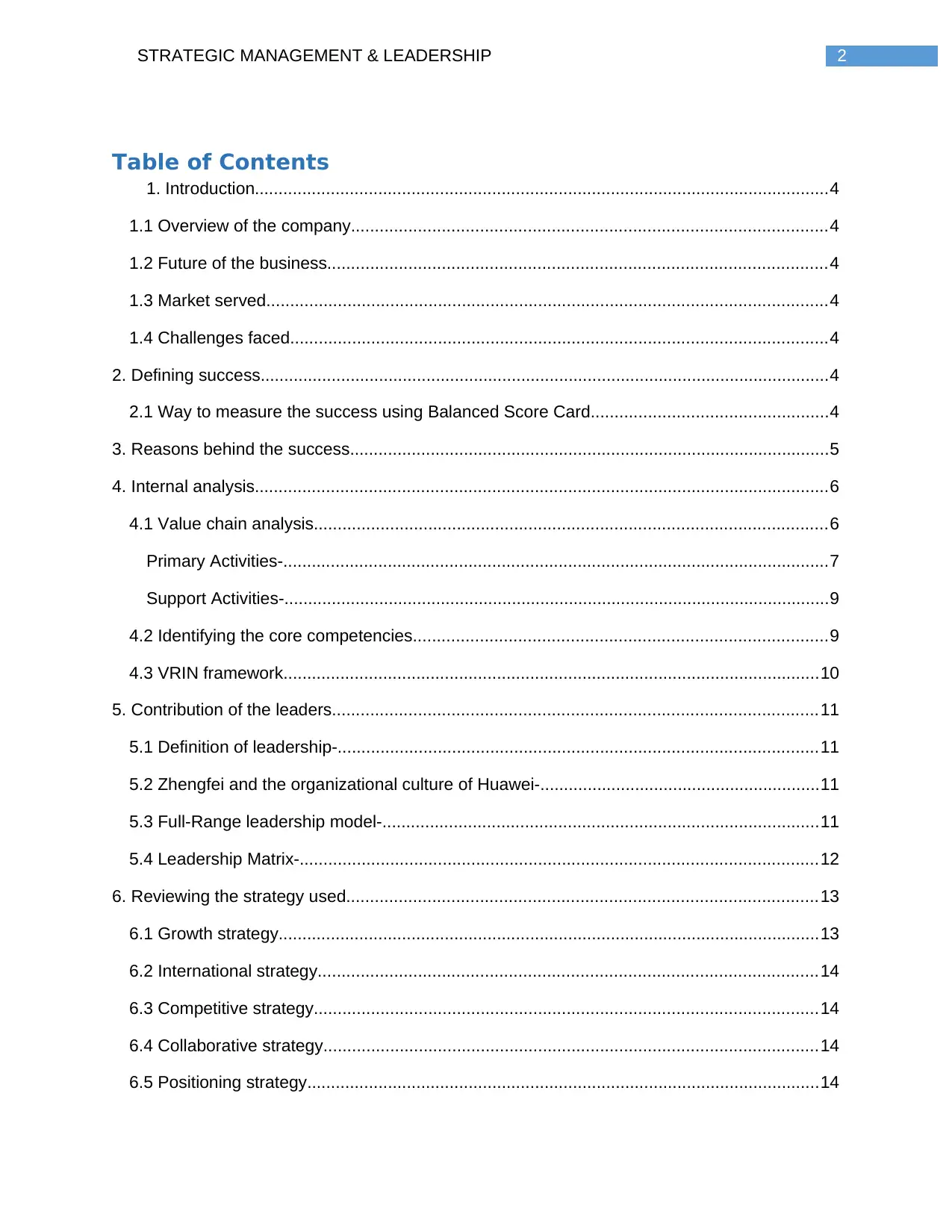
2STRATEGIC MANAGEMENT & LEADERSHIP
Table of Contents
1. Introduction.........................................................................................................................4
1.1 Overview of the company....................................................................................................4
1.2 Future of the business.........................................................................................................4
1.3 Market served......................................................................................................................4
1.4 Challenges faced.................................................................................................................4
2. Defining success........................................................................................................................4
2.1 Way to measure the success using Balanced Score Card..................................................4
3. Reasons behind the success.....................................................................................................5
4. Internal analysis.........................................................................................................................6
4.1 Value chain analysis............................................................................................................6
Primary Activities-...................................................................................................................7
Support Activities-...................................................................................................................9
4.2 Identifying the core competencies.......................................................................................9
4.3 VRIN framework.................................................................................................................10
5. Contribution of the leaders......................................................................................................11
5.1 Definition of leadership-.....................................................................................................11
5.2 Zhengfei and the organizational culture of Huawei-...........................................................11
5.3 Full-Range leadership model-............................................................................................11
5.4 Leadership Matrix-.............................................................................................................12
6. Reviewing the strategy used...................................................................................................13
6.1 Growth strategy..................................................................................................................13
6.2 International strategy.........................................................................................................14
6.3 Competitive strategy..........................................................................................................14
6.4 Collaborative strategy........................................................................................................14
6.5 Positioning strategy............................................................................................................14
Table of Contents
1. Introduction.........................................................................................................................4
1.1 Overview of the company....................................................................................................4
1.2 Future of the business.........................................................................................................4
1.3 Market served......................................................................................................................4
1.4 Challenges faced.................................................................................................................4
2. Defining success........................................................................................................................4
2.1 Way to measure the success using Balanced Score Card..................................................4
3. Reasons behind the success.....................................................................................................5
4. Internal analysis.........................................................................................................................6
4.1 Value chain analysis............................................................................................................6
Primary Activities-...................................................................................................................7
Support Activities-...................................................................................................................9
4.2 Identifying the core competencies.......................................................................................9
4.3 VRIN framework.................................................................................................................10
5. Contribution of the leaders......................................................................................................11
5.1 Definition of leadership-.....................................................................................................11
5.2 Zhengfei and the organizational culture of Huawei-...........................................................11
5.3 Full-Range leadership model-............................................................................................11
5.4 Leadership Matrix-.............................................................................................................12
6. Reviewing the strategy used...................................................................................................13
6.1 Growth strategy..................................................................................................................13
6.2 International strategy.........................................................................................................14
6.3 Competitive strategy..........................................................................................................14
6.4 Collaborative strategy........................................................................................................14
6.5 Positioning strategy............................................................................................................14
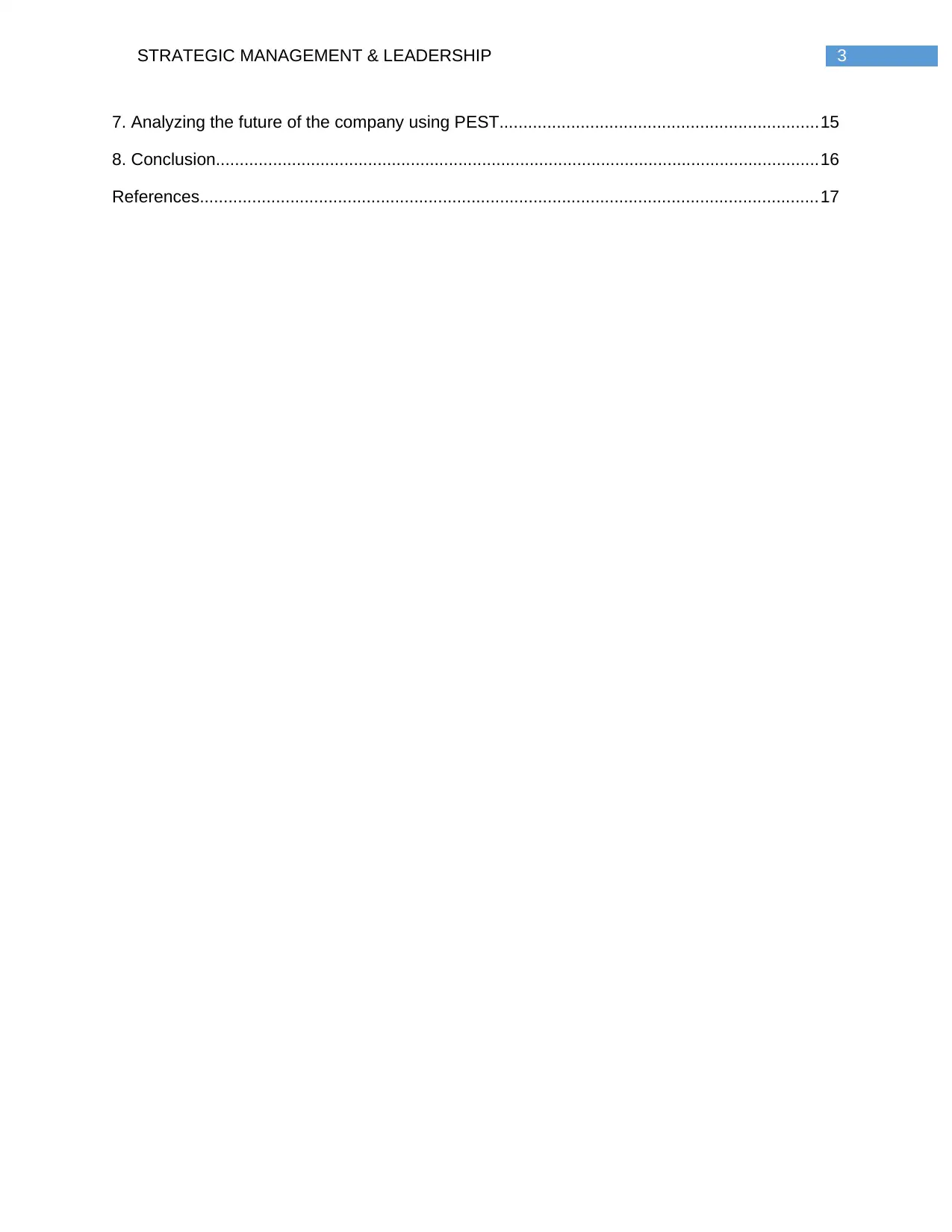
3STRATEGIC MANAGEMENT & LEADERSHIP
7. Analyzing the future of the company using PEST...................................................................15
8. Conclusion...............................................................................................................................16
References..................................................................................................................................17
7. Analyzing the future of the company using PEST...................................................................15
8. Conclusion...............................................................................................................................16
References..................................................................................................................................17
Secure Best Marks with AI Grader
Need help grading? Try our AI Grader for instant feedback on your assignments.
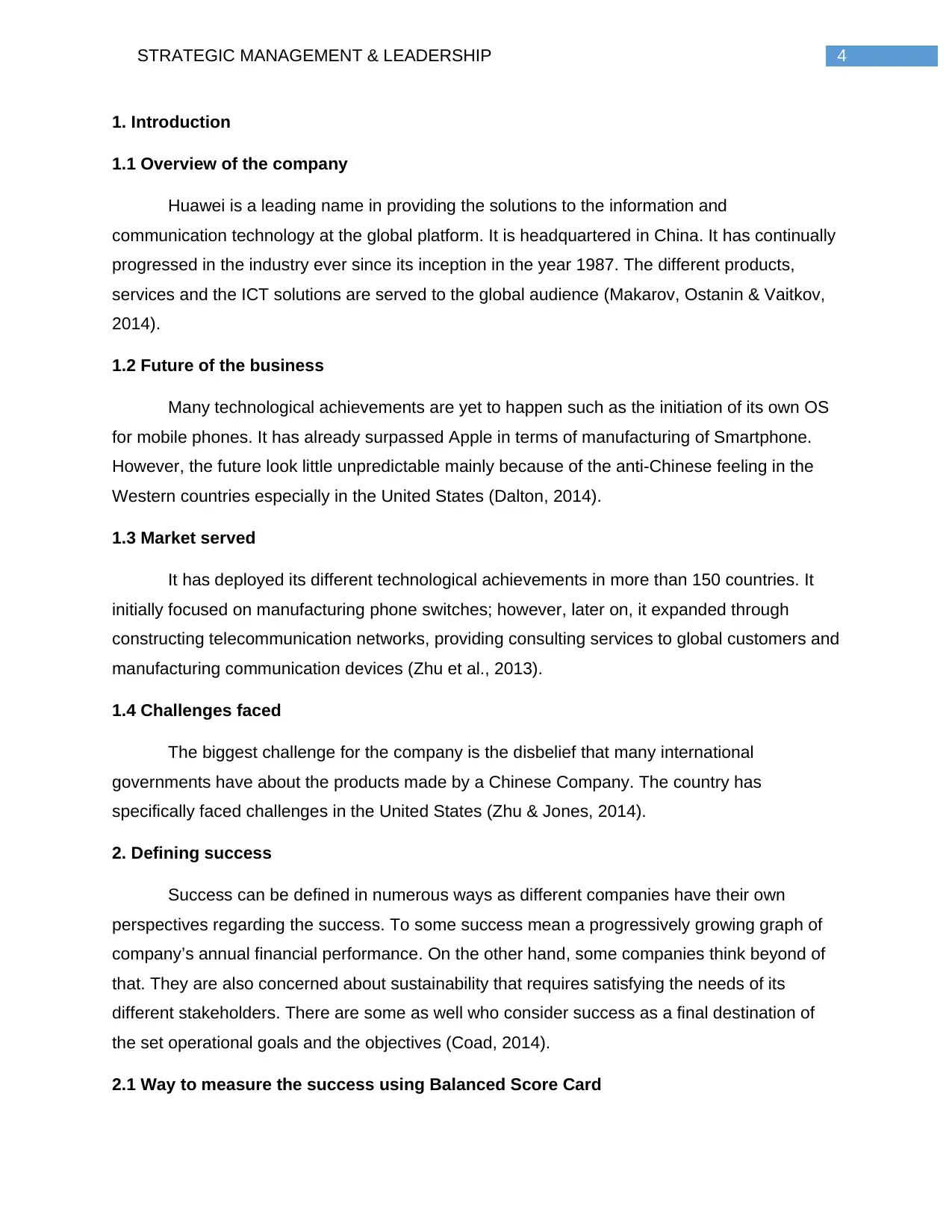
4STRATEGIC MANAGEMENT & LEADERSHIP
1. Introduction
1.1 Overview of the company
Huawei is a leading name in providing the solutions to the information and
communication technology at the global platform. It is headquartered in China. It has continually
progressed in the industry ever since its inception in the year 1987. The different products,
services and the ICT solutions are served to the global audience (Makarov, Ostanin & Vaitkov,
2014).
1.2 Future of the business
Many technological achievements are yet to happen such as the initiation of its own OS
for mobile phones. It has already surpassed Apple in terms of manufacturing of Smartphone.
However, the future look little unpredictable mainly because of the anti-Chinese feeling in the
Western countries especially in the United States (Dalton, 2014).
1.3 Market served
It has deployed its different technological achievements in more than 150 countries. It
initially focused on manufacturing phone switches; however, later on, it expanded through
constructing telecommunication networks, providing consulting services to global customers and
manufacturing communication devices (Zhu et al., 2013).
1.4 Challenges faced
The biggest challenge for the company is the disbelief that many international
governments have about the products made by a Chinese Company. The country has
specifically faced challenges in the United States (Zhu & Jones, 2014).
2. Defining success
Success can be defined in numerous ways as different companies have their own
perspectives regarding the success. To some success mean a progressively growing graph of
company’s annual financial performance. On the other hand, some companies think beyond of
that. They are also concerned about sustainability that requires satisfying the needs of its
different stakeholders. There are some as well who consider success as a final destination of
the set operational goals and the objectives (Coad, 2014).
2.1 Way to measure the success using Balanced Score Card
1. Introduction
1.1 Overview of the company
Huawei is a leading name in providing the solutions to the information and
communication technology at the global platform. It is headquartered in China. It has continually
progressed in the industry ever since its inception in the year 1987. The different products,
services and the ICT solutions are served to the global audience (Makarov, Ostanin & Vaitkov,
2014).
1.2 Future of the business
Many technological achievements are yet to happen such as the initiation of its own OS
for mobile phones. It has already surpassed Apple in terms of manufacturing of Smartphone.
However, the future look little unpredictable mainly because of the anti-Chinese feeling in the
Western countries especially in the United States (Dalton, 2014).
1.3 Market served
It has deployed its different technological achievements in more than 150 countries. It
initially focused on manufacturing phone switches; however, later on, it expanded through
constructing telecommunication networks, providing consulting services to global customers and
manufacturing communication devices (Zhu et al., 2013).
1.4 Challenges faced
The biggest challenge for the company is the disbelief that many international
governments have about the products made by a Chinese Company. The country has
specifically faced challenges in the United States (Zhu & Jones, 2014).
2. Defining success
Success can be defined in numerous ways as different companies have their own
perspectives regarding the success. To some success mean a progressively growing graph of
company’s annual financial performance. On the other hand, some companies think beyond of
that. They are also concerned about sustainability that requires satisfying the needs of its
different stakeholders. There are some as well who consider success as a final destination of
the set operational goals and the objectives (Coad, 2014).
2.1 Way to measure the success using Balanced Score Card
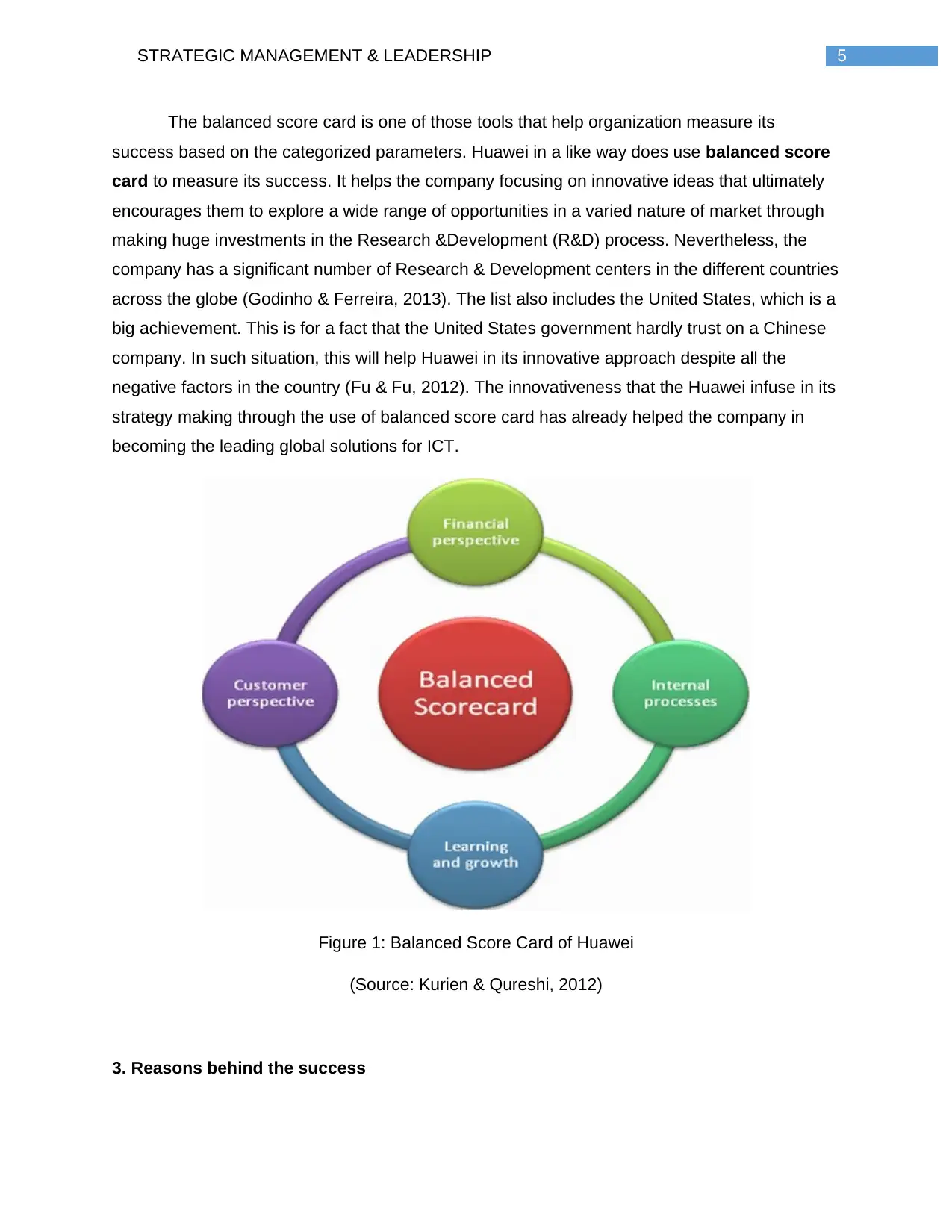
5STRATEGIC MANAGEMENT & LEADERSHIP
The balanced score card is one of those tools that help organization measure its
success based on the categorized parameters. Huawei in a like way does use balanced score
card to measure its success. It helps the company focusing on innovative ideas that ultimately
encourages them to explore a wide range of opportunities in a varied nature of market through
making huge investments in the Research &Development (R&D) process. Nevertheless, the
company has a significant number of Research & Development centers in the different countries
across the globe (Godinho & Ferreira, 2013). The list also includes the United States, which is a
big achievement. This is for a fact that the United States government hardly trust on a Chinese
company. In such situation, this will help Huawei in its innovative approach despite all the
negative factors in the country (Fu & Fu, 2012). The innovativeness that the Huawei infuse in its
strategy making through the use of balanced score card has already helped the company in
becoming the leading global solutions for ICT.
Figure 1: Balanced Score Card of Huawei
(Source: Kurien & Qureshi, 2012)
3. Reasons behind the success
The balanced score card is one of those tools that help organization measure its
success based on the categorized parameters. Huawei in a like way does use balanced score
card to measure its success. It helps the company focusing on innovative ideas that ultimately
encourages them to explore a wide range of opportunities in a varied nature of market through
making huge investments in the Research &Development (R&D) process. Nevertheless, the
company has a significant number of Research & Development centers in the different countries
across the globe (Godinho & Ferreira, 2013). The list also includes the United States, which is a
big achievement. This is for a fact that the United States government hardly trust on a Chinese
company. In such situation, this will help Huawei in its innovative approach despite all the
negative factors in the country (Fu & Fu, 2012). The innovativeness that the Huawei infuse in its
strategy making through the use of balanced score card has already helped the company in
becoming the leading global solutions for ICT.
Figure 1: Balanced Score Card of Huawei
(Source: Kurien & Qureshi, 2012)
3. Reasons behind the success
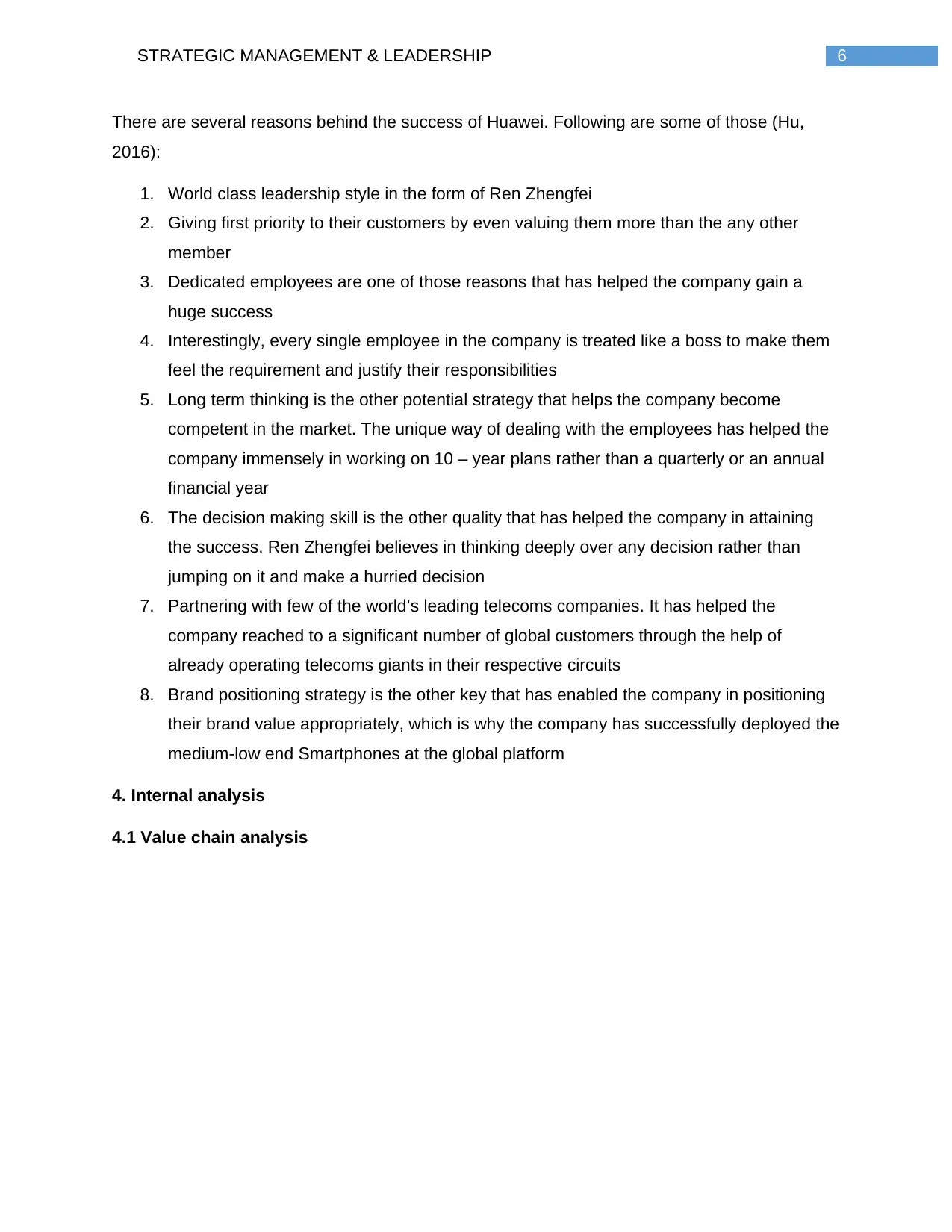
6STRATEGIC MANAGEMENT & LEADERSHIP
There are several reasons behind the success of Huawei. Following are some of those (Hu,
2016):
1. World class leadership style in the form of Ren Zhengfei
2. Giving first priority to their customers by even valuing them more than the any other
member
3. Dedicated employees are one of those reasons that has helped the company gain a
huge success
4. Interestingly, every single employee in the company is treated like a boss to make them
feel the requirement and justify their responsibilities
5. Long term thinking is the other potential strategy that helps the company become
competent in the market. The unique way of dealing with the employees has helped the
company immensely in working on 10 – year plans rather than a quarterly or an annual
financial year
6. The decision making skill is the other quality that has helped the company in attaining
the success. Ren Zhengfei believes in thinking deeply over any decision rather than
jumping on it and make a hurried decision
7. Partnering with few of the world’s leading telecoms companies. It has helped the
company reached to a significant number of global customers through the help of
already operating telecoms giants in their respective circuits
8. Brand positioning strategy is the other key that has enabled the company in positioning
their brand value appropriately, which is why the company has successfully deployed the
medium-low end Smartphones at the global platform
4. Internal analysis
4.1 Value chain analysis
There are several reasons behind the success of Huawei. Following are some of those (Hu,
2016):
1. World class leadership style in the form of Ren Zhengfei
2. Giving first priority to their customers by even valuing them more than the any other
member
3. Dedicated employees are one of those reasons that has helped the company gain a
huge success
4. Interestingly, every single employee in the company is treated like a boss to make them
feel the requirement and justify their responsibilities
5. Long term thinking is the other potential strategy that helps the company become
competent in the market. The unique way of dealing with the employees has helped the
company immensely in working on 10 – year plans rather than a quarterly or an annual
financial year
6. The decision making skill is the other quality that has helped the company in attaining
the success. Ren Zhengfei believes in thinking deeply over any decision rather than
jumping on it and make a hurried decision
7. Partnering with few of the world’s leading telecoms companies. It has helped the
company reached to a significant number of global customers through the help of
already operating telecoms giants in their respective circuits
8. Brand positioning strategy is the other key that has enabled the company in positioning
their brand value appropriately, which is why the company has successfully deployed the
medium-low end Smartphones at the global platform
4. Internal analysis
4.1 Value chain analysis
Paraphrase This Document
Need a fresh take? Get an instant paraphrase of this document with our AI Paraphraser
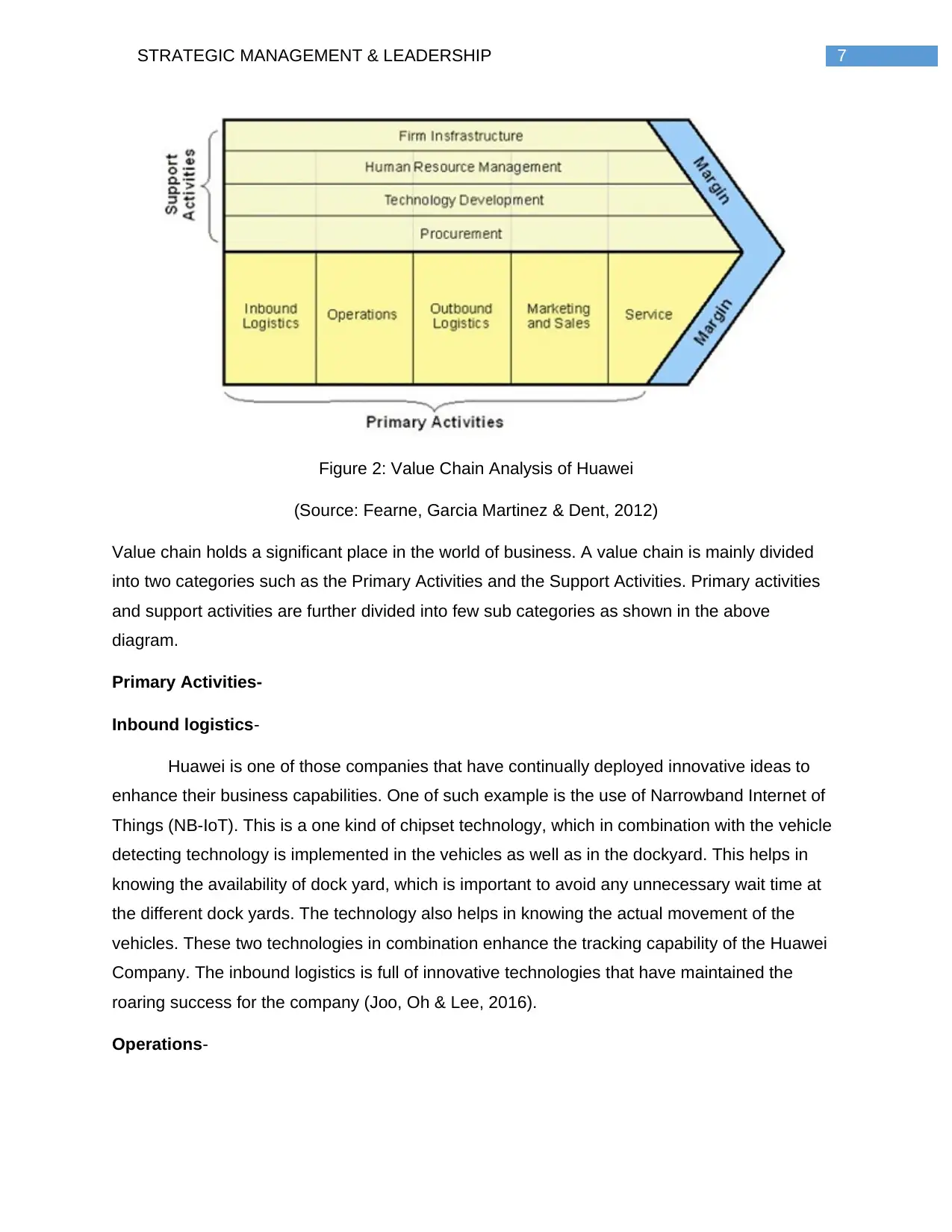
7STRATEGIC MANAGEMENT & LEADERSHIP
Figure 2: Value Chain Analysis of Huawei
(Source: Fearne, Garcia Martinez & Dent, 2012)
Value chain holds a significant place in the world of business. A value chain is mainly divided
into two categories such as the Primary Activities and the Support Activities. Primary activities
and support activities are further divided into few sub categories as shown in the above
diagram.
Primary Activities-
Inbound logistics-
Huawei is one of those companies that have continually deployed innovative ideas to
enhance their business capabilities. One of such example is the use of Narrowband Internet of
Things (NB-IoT). This is a one kind of chipset technology, which in combination with the vehicle
detecting technology is implemented in the vehicles as well as in the dockyard. This helps in
knowing the availability of dock yard, which is important to avoid any unnecessary wait time at
the different dock yards. The technology also helps in knowing the actual movement of the
vehicles. These two technologies in combination enhance the tracking capability of the Huawei
Company. The inbound logistics is full of innovative technologies that have maintained the
roaring success for the company (Joo, Oh & Lee, 2016).
Operations-
Figure 2: Value Chain Analysis of Huawei
(Source: Fearne, Garcia Martinez & Dent, 2012)
Value chain holds a significant place in the world of business. A value chain is mainly divided
into two categories such as the Primary Activities and the Support Activities. Primary activities
and support activities are further divided into few sub categories as shown in the above
diagram.
Primary Activities-
Inbound logistics-
Huawei is one of those companies that have continually deployed innovative ideas to
enhance their business capabilities. One of such example is the use of Narrowband Internet of
Things (NB-IoT). This is a one kind of chipset technology, which in combination with the vehicle
detecting technology is implemented in the vehicles as well as in the dockyard. This helps in
knowing the availability of dock yard, which is important to avoid any unnecessary wait time at
the different dock yards. The technology also helps in knowing the actual movement of the
vehicles. These two technologies in combination enhance the tracking capability of the Huawei
Company. The inbound logistics is full of innovative technologies that have maintained the
roaring success for the company (Joo, Oh & Lee, 2016).
Operations-
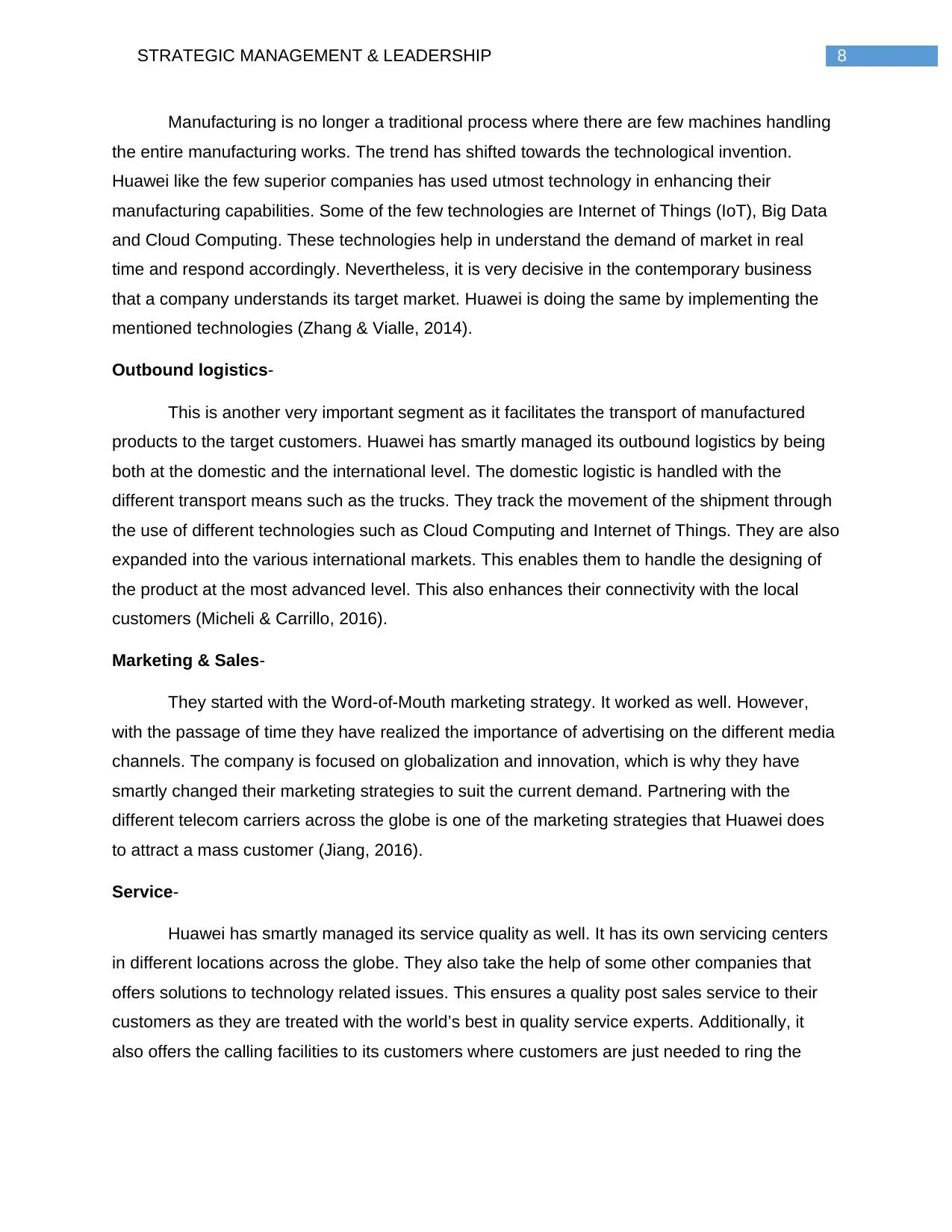
8STRATEGIC MANAGEMENT & LEADERSHIP
Manufacturing is no longer a traditional process where there are few machines handling
the entire manufacturing works. The trend has shifted towards the technological invention.
Huawei like the few superior companies has used utmost technology in enhancing their
manufacturing capabilities. Some of the few technologies are Internet of Things (IoT), Big Data
and Cloud Computing. These technologies help in understand the demand of market in real
time and respond accordingly. Nevertheless, it is very decisive in the contemporary business
that a company understands its target market. Huawei is doing the same by implementing the
mentioned technologies (Zhang & Vialle, 2014).
Outbound logistics-
This is another very important segment as it facilitates the transport of manufactured
products to the target customers. Huawei has smartly managed its outbound logistics by being
both at the domestic and the international level. The domestic logistic is handled with the
different transport means such as the trucks. They track the movement of the shipment through
the use of different technologies such as Cloud Computing and Internet of Things. They are also
expanded into the various international markets. This enables them to handle the designing of
the product at the most advanced level. This also enhances their connectivity with the local
customers (Micheli & Carrillo, 2016).
Marketing & Sales-
They started with the Word-of-Mouth marketing strategy. It worked as well. However,
with the passage of time they have realized the importance of advertising on the different media
channels. The company is focused on globalization and innovation, which is why they have
smartly changed their marketing strategies to suit the current demand. Partnering with the
different telecom carriers across the globe is one of the marketing strategies that Huawei does
to attract a mass customer (Jiang, 2016).
Service-
Huawei has smartly managed its service quality as well. It has its own servicing centers
in different locations across the globe. They also take the help of some other companies that
offers solutions to technology related issues. This ensures a quality post sales service to their
customers as they are treated with the world’s best in quality service experts. Additionally, it
also offers the calling facilities to its customers where customers are just needed to ring the
Manufacturing is no longer a traditional process where there are few machines handling
the entire manufacturing works. The trend has shifted towards the technological invention.
Huawei like the few superior companies has used utmost technology in enhancing their
manufacturing capabilities. Some of the few technologies are Internet of Things (IoT), Big Data
and Cloud Computing. These technologies help in understand the demand of market in real
time and respond accordingly. Nevertheless, it is very decisive in the contemporary business
that a company understands its target market. Huawei is doing the same by implementing the
mentioned technologies (Zhang & Vialle, 2014).
Outbound logistics-
This is another very important segment as it facilitates the transport of manufactured
products to the target customers. Huawei has smartly managed its outbound logistics by being
both at the domestic and the international level. The domestic logistic is handled with the
different transport means such as the trucks. They track the movement of the shipment through
the use of different technologies such as Cloud Computing and Internet of Things. They are also
expanded into the various international markets. This enables them to handle the designing of
the product at the most advanced level. This also enhances their connectivity with the local
customers (Micheli & Carrillo, 2016).
Marketing & Sales-
They started with the Word-of-Mouth marketing strategy. It worked as well. However,
with the passage of time they have realized the importance of advertising on the different media
channels. The company is focused on globalization and innovation, which is why they have
smartly changed their marketing strategies to suit the current demand. Partnering with the
different telecom carriers across the globe is one of the marketing strategies that Huawei does
to attract a mass customer (Jiang, 2016).
Service-
Huawei has smartly managed its service quality as well. It has its own servicing centers
in different locations across the globe. They also take the help of some other companies that
offers solutions to technology related issues. This ensures a quality post sales service to their
customers as they are treated with the world’s best in quality service experts. Additionally, it
also offers the calling facilities to its customers where customers are just needed to ring the
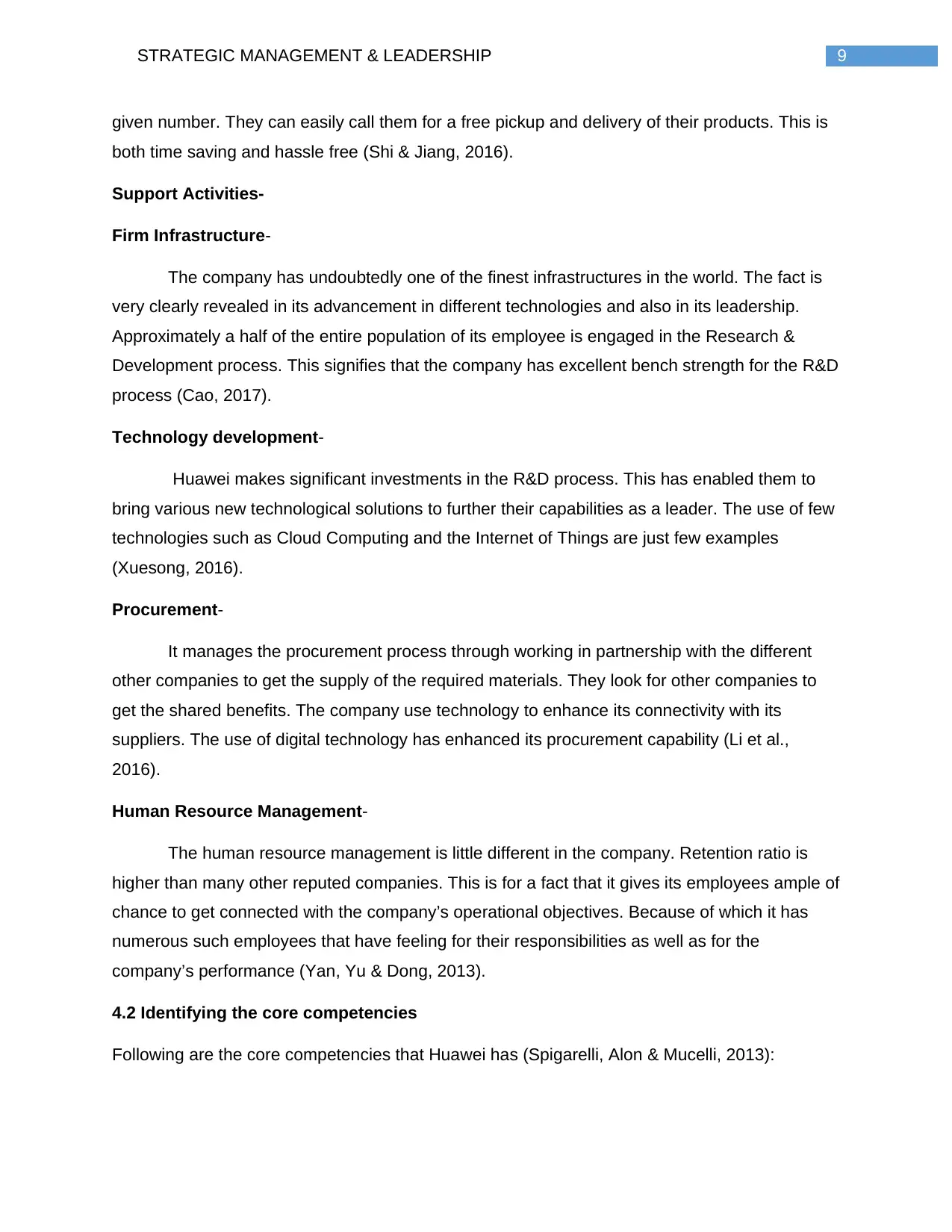
9STRATEGIC MANAGEMENT & LEADERSHIP
given number. They can easily call them for a free pickup and delivery of their products. This is
both time saving and hassle free (Shi & Jiang, 2016).
Support Activities-
Firm Infrastructure-
The company has undoubtedly one of the finest infrastructures in the world. The fact is
very clearly revealed in its advancement in different technologies and also in its leadership.
Approximately a half of the entire population of its employee is engaged in the Research &
Development process. This signifies that the company has excellent bench strength for the R&D
process (Cao, 2017).
Technology development-
Huawei makes significant investments in the R&D process. This has enabled them to
bring various new technological solutions to further their capabilities as a leader. The use of few
technologies such as Cloud Computing and the Internet of Things are just few examples
(Xuesong, 2016).
Procurement-
It manages the procurement process through working in partnership with the different
other companies to get the supply of the required materials. They look for other companies to
get the shared benefits. The company use technology to enhance its connectivity with its
suppliers. The use of digital technology has enhanced its procurement capability (Li et al.,
2016).
Human Resource Management-
The human resource management is little different in the company. Retention ratio is
higher than many other reputed companies. This is for a fact that it gives its employees ample of
chance to get connected with the company’s operational objectives. Because of which it has
numerous such employees that have feeling for their responsibilities as well as for the
company’s performance (Yan, Yu & Dong, 2013).
4.2 Identifying the core competencies
Following are the core competencies that Huawei has (Spigarelli, Alon & Mucelli, 2013):
given number. They can easily call them for a free pickup and delivery of their products. This is
both time saving and hassle free (Shi & Jiang, 2016).
Support Activities-
Firm Infrastructure-
The company has undoubtedly one of the finest infrastructures in the world. The fact is
very clearly revealed in its advancement in different technologies and also in its leadership.
Approximately a half of the entire population of its employee is engaged in the Research &
Development process. This signifies that the company has excellent bench strength for the R&D
process (Cao, 2017).
Technology development-
Huawei makes significant investments in the R&D process. This has enabled them to
bring various new technological solutions to further their capabilities as a leader. The use of few
technologies such as Cloud Computing and the Internet of Things are just few examples
(Xuesong, 2016).
Procurement-
It manages the procurement process through working in partnership with the different
other companies to get the supply of the required materials. They look for other companies to
get the shared benefits. The company use technology to enhance its connectivity with its
suppliers. The use of digital technology has enhanced its procurement capability (Li et al.,
2016).
Human Resource Management-
The human resource management is little different in the company. Retention ratio is
higher than many other reputed companies. This is for a fact that it gives its employees ample of
chance to get connected with the company’s operational objectives. Because of which it has
numerous such employees that have feeling for their responsibilities as well as for the
company’s performance (Yan, Yu & Dong, 2013).
4.2 Identifying the core competencies
Following are the core competencies that Huawei has (Spigarelli, Alon & Mucelli, 2013):
Secure Best Marks with AI Grader
Need help grading? Try our AI Grader for instant feedback on your assignments.
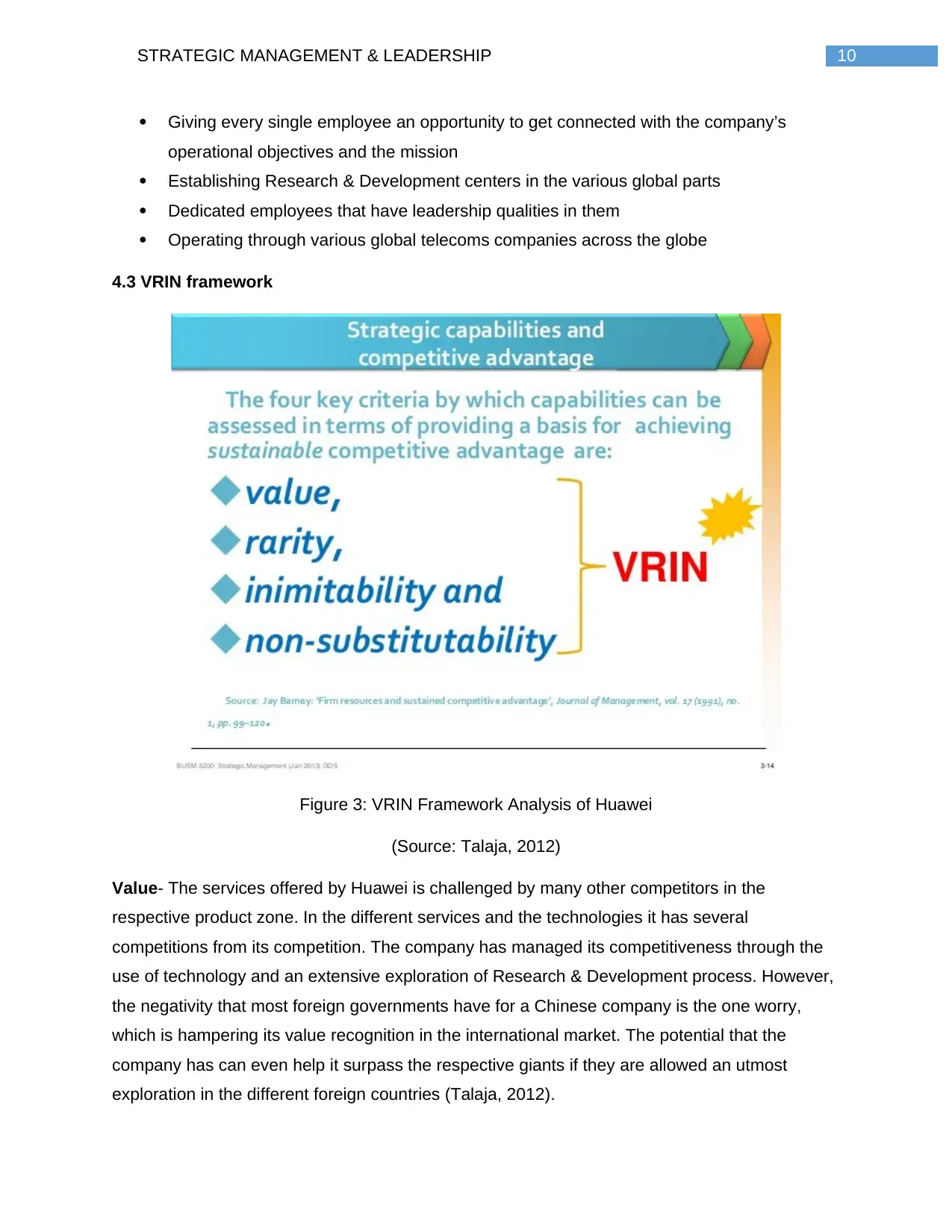
10STRATEGIC MANAGEMENT & LEADERSHIP
Giving every single employee an opportunity to get connected with the company’s
operational objectives and the mission
Establishing Research & Development centers in the various global parts
Dedicated employees that have leadership qualities in them
Operating through various global telecoms companies across the globe
4.3 VRIN framework
Figure 3: VRIN Framework Analysis of Huawei
(Source: Talaja, 2012)
Value- The services offered by Huawei is challenged by many other competitors in the
respective product zone. In the different services and the technologies it has several
competitions from its competition. The company has managed its competitiveness through the
use of technology and an extensive exploration of Research & Development process. However,
the negativity that most foreign governments have for a Chinese company is the one worry,
which is hampering its value recognition in the international market. The potential that the
company has can even help it surpass the respective giants if they are allowed an utmost
exploration in the different foreign countries (Talaja, 2012).
Giving every single employee an opportunity to get connected with the company’s
operational objectives and the mission
Establishing Research & Development centers in the various global parts
Dedicated employees that have leadership qualities in them
Operating through various global telecoms companies across the globe
4.3 VRIN framework
Figure 3: VRIN Framework Analysis of Huawei
(Source: Talaja, 2012)
Value- The services offered by Huawei is challenged by many other competitors in the
respective product zone. In the different services and the technologies it has several
competitions from its competition. The company has managed its competitiveness through the
use of technology and an extensive exploration of Research & Development process. However,
the negativity that most foreign governments have for a Chinese company is the one worry,
which is hampering its value recognition in the international market. The potential that the
company has can even help it surpass the respective giants if they are allowed an utmost
exploration in the different foreign countries (Talaja, 2012).
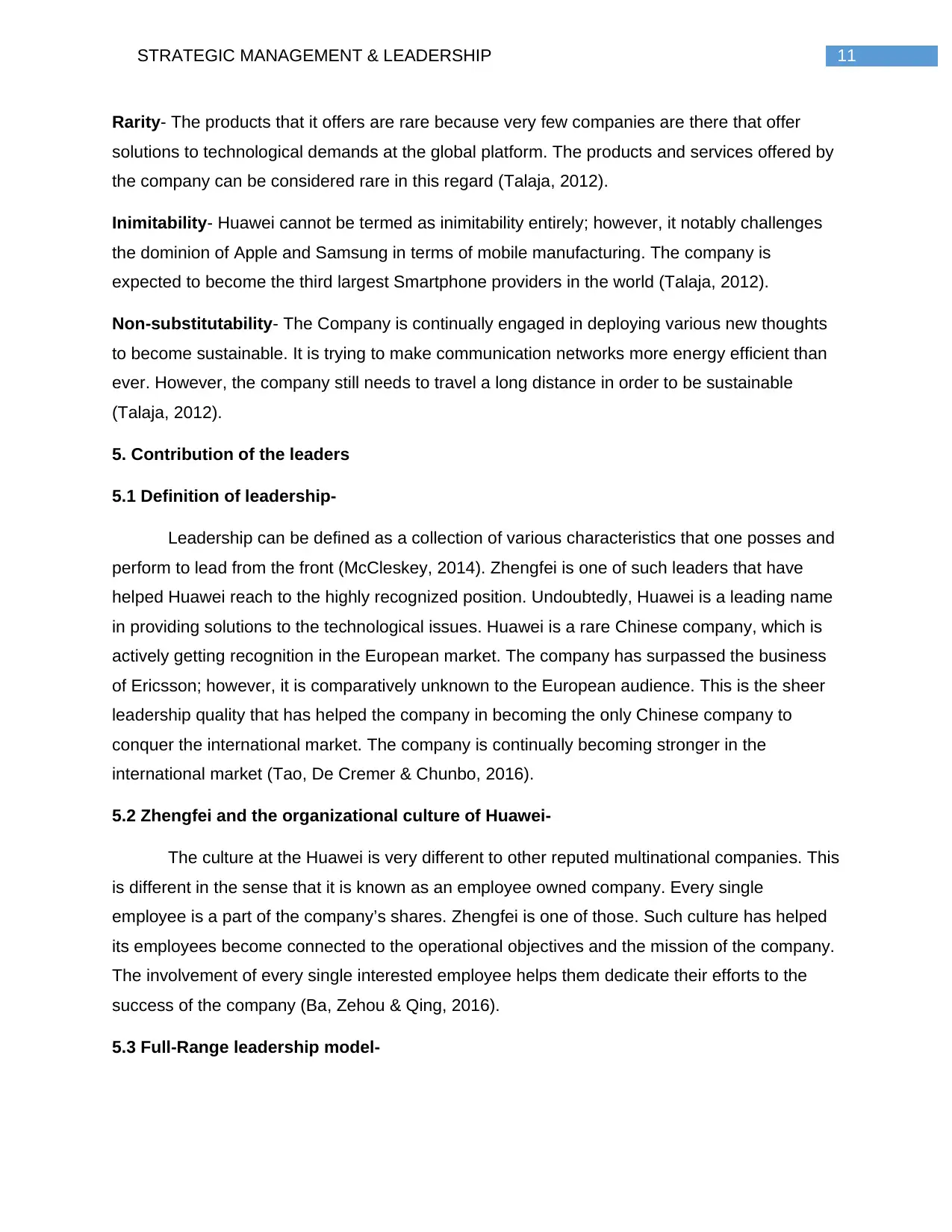
11STRATEGIC MANAGEMENT & LEADERSHIP
Rarity- The products that it offers are rare because very few companies are there that offer
solutions to technological demands at the global platform. The products and services offered by
the company can be considered rare in this regard (Talaja, 2012).
Inimitability- Huawei cannot be termed as inimitability entirely; however, it notably challenges
the dominion of Apple and Samsung in terms of mobile manufacturing. The company is
expected to become the third largest Smartphone providers in the world (Talaja, 2012).
Non-substitutability- The Company is continually engaged in deploying various new thoughts
to become sustainable. It is trying to make communication networks more energy efficient than
ever. However, the company still needs to travel a long distance in order to be sustainable
(Talaja, 2012).
5. Contribution of the leaders
5.1 Definition of leadership-
Leadership can be defined as a collection of various characteristics that one posses and
perform to lead from the front (McCleskey, 2014). Zhengfei is one of such leaders that have
helped Huawei reach to the highly recognized position. Undoubtedly, Huawei is a leading name
in providing solutions to the technological issues. Huawei is a rare Chinese company, which is
actively getting recognition in the European market. The company has surpassed the business
of Ericsson; however, it is comparatively unknown to the European audience. This is the sheer
leadership quality that has helped the company in becoming the only Chinese company to
conquer the international market. The company is continually becoming stronger in the
international market (Tao, De Cremer & Chunbo, 2016).
5.2 Zhengfei and the organizational culture of Huawei-
The culture at the Huawei is very different to other reputed multinational companies. This
is different in the sense that it is known as an employee owned company. Every single
employee is a part of the company’s shares. Zhengfei is one of those. Such culture has helped
its employees become connected to the operational objectives and the mission of the company.
The involvement of every single interested employee helps them dedicate their efforts to the
success of the company (Ba, Zehou & Qing, 2016).
5.3 Full-Range leadership model-
Rarity- The products that it offers are rare because very few companies are there that offer
solutions to technological demands at the global platform. The products and services offered by
the company can be considered rare in this regard (Talaja, 2012).
Inimitability- Huawei cannot be termed as inimitability entirely; however, it notably challenges
the dominion of Apple and Samsung in terms of mobile manufacturing. The company is
expected to become the third largest Smartphone providers in the world (Talaja, 2012).
Non-substitutability- The Company is continually engaged in deploying various new thoughts
to become sustainable. It is trying to make communication networks more energy efficient than
ever. However, the company still needs to travel a long distance in order to be sustainable
(Talaja, 2012).
5. Contribution of the leaders
5.1 Definition of leadership-
Leadership can be defined as a collection of various characteristics that one posses and
perform to lead from the front (McCleskey, 2014). Zhengfei is one of such leaders that have
helped Huawei reach to the highly recognized position. Undoubtedly, Huawei is a leading name
in providing solutions to the technological issues. Huawei is a rare Chinese company, which is
actively getting recognition in the European market. The company has surpassed the business
of Ericsson; however, it is comparatively unknown to the European audience. This is the sheer
leadership quality that has helped the company in becoming the only Chinese company to
conquer the international market. The company is continually becoming stronger in the
international market (Tao, De Cremer & Chunbo, 2016).
5.2 Zhengfei and the organizational culture of Huawei-
The culture at the Huawei is very different to other reputed multinational companies. This
is different in the sense that it is known as an employee owned company. Every single
employee is a part of the company’s shares. Zhengfei is one of those. Such culture has helped
its employees become connected to the operational objectives and the mission of the company.
The involvement of every single interested employee helps them dedicate their efforts to the
success of the company (Ba, Zehou & Qing, 2016).
5.3 Full-Range leadership model-
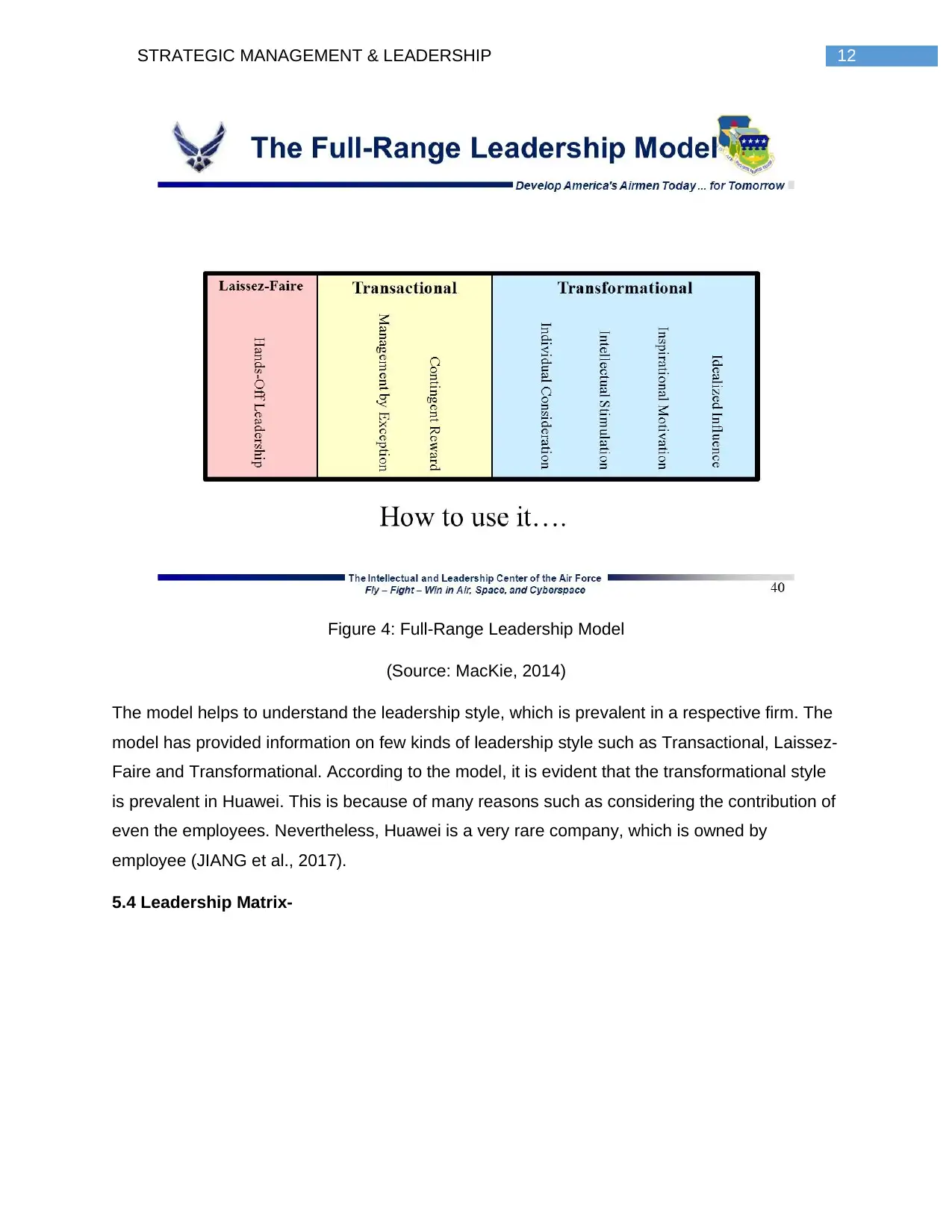
12STRATEGIC MANAGEMENT & LEADERSHIP
Figure 4: Full-Range Leadership Model
(Source: MacKie, 2014)
The model helps to understand the leadership style, which is prevalent in a respective firm. The
model has provided information on few kinds of leadership style such as Transactional, Laissez-
Faire and Transformational. According to the model, it is evident that the transformational style
is prevalent in Huawei. This is because of many reasons such as considering the contribution of
even the employees. Nevertheless, Huawei is a very rare company, which is owned by
employee (JIANG et al., 2017).
5.4 Leadership Matrix-
Figure 4: Full-Range Leadership Model
(Source: MacKie, 2014)
The model helps to understand the leadership style, which is prevalent in a respective firm. The
model has provided information on few kinds of leadership style such as Transactional, Laissez-
Faire and Transformational. According to the model, it is evident that the transformational style
is prevalent in Huawei. This is because of many reasons such as considering the contribution of
even the employees. Nevertheless, Huawei is a very rare company, which is owned by
employee (JIANG et al., 2017).
5.4 Leadership Matrix-
Paraphrase This Document
Need a fresh take? Get an instant paraphrase of this document with our AI Paraphraser
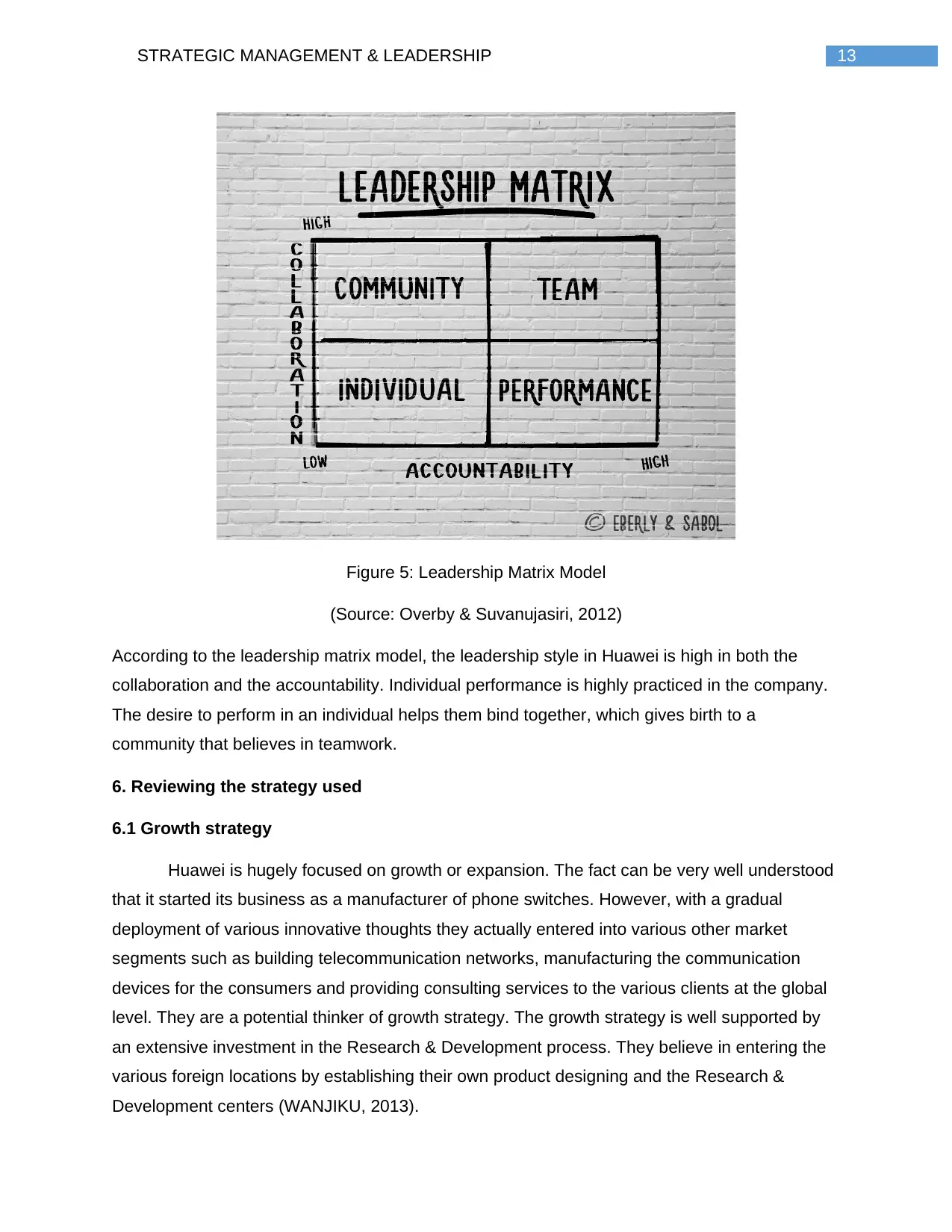
13STRATEGIC MANAGEMENT & LEADERSHIP
Figure 5: Leadership Matrix Model
(Source: Overby & Suvanujasiri, 2012)
According to the leadership matrix model, the leadership style in Huawei is high in both the
collaboration and the accountability. Individual performance is highly practiced in the company.
The desire to perform in an individual helps them bind together, which gives birth to a
community that believes in teamwork.
6. Reviewing the strategy used
6.1 Growth strategy
Huawei is hugely focused on growth or expansion. The fact can be very well understood
that it started its business as a manufacturer of phone switches. However, with a gradual
deployment of various innovative thoughts they actually entered into various other market
segments such as building telecommunication networks, manufacturing the communication
devices for the consumers and providing consulting services to the various clients at the global
level. They are a potential thinker of growth strategy. The growth strategy is well supported by
an extensive investment in the Research & Development process. They believe in entering the
various foreign locations by establishing their own product designing and the Research &
Development centers (WANJIKU, 2013).
Figure 5: Leadership Matrix Model
(Source: Overby & Suvanujasiri, 2012)
According to the leadership matrix model, the leadership style in Huawei is high in both the
collaboration and the accountability. Individual performance is highly practiced in the company.
The desire to perform in an individual helps them bind together, which gives birth to a
community that believes in teamwork.
6. Reviewing the strategy used
6.1 Growth strategy
Huawei is hugely focused on growth or expansion. The fact can be very well understood
that it started its business as a manufacturer of phone switches. However, with a gradual
deployment of various innovative thoughts they actually entered into various other market
segments such as building telecommunication networks, manufacturing the communication
devices for the consumers and providing consulting services to the various clients at the global
level. They are a potential thinker of growth strategy. The growth strategy is well supported by
an extensive investment in the Research & Development process. They believe in entering the
various foreign locations by establishing their own product designing and the Research &
Development centers (WANJIKU, 2013).
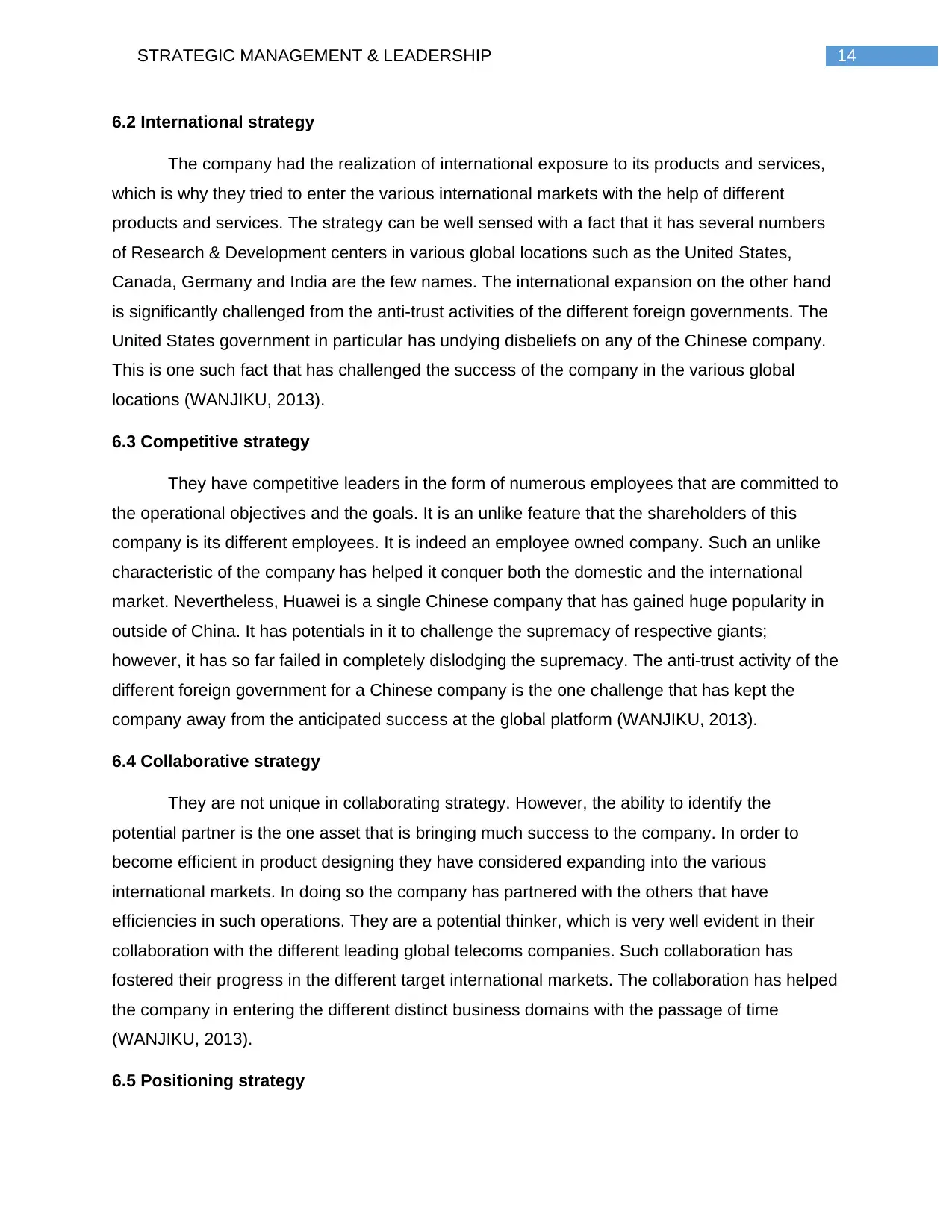
14STRATEGIC MANAGEMENT & LEADERSHIP
6.2 International strategy
The company had the realization of international exposure to its products and services,
which is why they tried to enter the various international markets with the help of different
products and services. The strategy can be well sensed with a fact that it has several numbers
of Research & Development centers in various global locations such as the United States,
Canada, Germany and India are the few names. The international expansion on the other hand
is significantly challenged from the anti-trust activities of the different foreign governments. The
United States government in particular has undying disbeliefs on any of the Chinese company.
This is one such fact that has challenged the success of the company in the various global
locations (WANJIKU, 2013).
6.3 Competitive strategy
They have competitive leaders in the form of numerous employees that are committed to
the operational objectives and the goals. It is an unlike feature that the shareholders of this
company is its different employees. It is indeed an employee owned company. Such an unlike
characteristic of the company has helped it conquer both the domestic and the international
market. Nevertheless, Huawei is a single Chinese company that has gained huge popularity in
outside of China. It has potentials in it to challenge the supremacy of respective giants;
however, it has so far failed in completely dislodging the supremacy. The anti-trust activity of the
different foreign government for a Chinese company is the one challenge that has kept the
company away from the anticipated success at the global platform (WANJIKU, 2013).
6.4 Collaborative strategy
They are not unique in collaborating strategy. However, the ability to identify the
potential partner is the one asset that is bringing much success to the company. In order to
become efficient in product designing they have considered expanding into the various
international markets. In doing so the company has partnered with the others that have
efficiencies in such operations. They are a potential thinker, which is very well evident in their
collaboration with the different leading global telecoms companies. Such collaboration has
fostered their progress in the different target international markets. The collaboration has helped
the company in entering the different distinct business domains with the passage of time
(WANJIKU, 2013).
6.5 Positioning strategy
6.2 International strategy
The company had the realization of international exposure to its products and services,
which is why they tried to enter the various international markets with the help of different
products and services. The strategy can be well sensed with a fact that it has several numbers
of Research & Development centers in various global locations such as the United States,
Canada, Germany and India are the few names. The international expansion on the other hand
is significantly challenged from the anti-trust activities of the different foreign governments. The
United States government in particular has undying disbeliefs on any of the Chinese company.
This is one such fact that has challenged the success of the company in the various global
locations (WANJIKU, 2013).
6.3 Competitive strategy
They have competitive leaders in the form of numerous employees that are committed to
the operational objectives and the goals. It is an unlike feature that the shareholders of this
company is its different employees. It is indeed an employee owned company. Such an unlike
characteristic of the company has helped it conquer both the domestic and the international
market. Nevertheless, Huawei is a single Chinese company that has gained huge popularity in
outside of China. It has potentials in it to challenge the supremacy of respective giants;
however, it has so far failed in completely dislodging the supremacy. The anti-trust activity of the
different foreign government for a Chinese company is the one challenge that has kept the
company away from the anticipated success at the global platform (WANJIKU, 2013).
6.4 Collaborative strategy
They are not unique in collaborating strategy. However, the ability to identify the
potential partner is the one asset that is bringing much success to the company. In order to
become efficient in product designing they have considered expanding into the various
international markets. In doing so the company has partnered with the others that have
efficiencies in such operations. They are a potential thinker, which is very well evident in their
collaboration with the different leading global telecoms companies. Such collaboration has
fostered their progress in the different target international markets. The collaboration has helped
the company in entering the different distinct business domains with the passage of time
(WANJIKU, 2013).
6.5 Positioning strategy
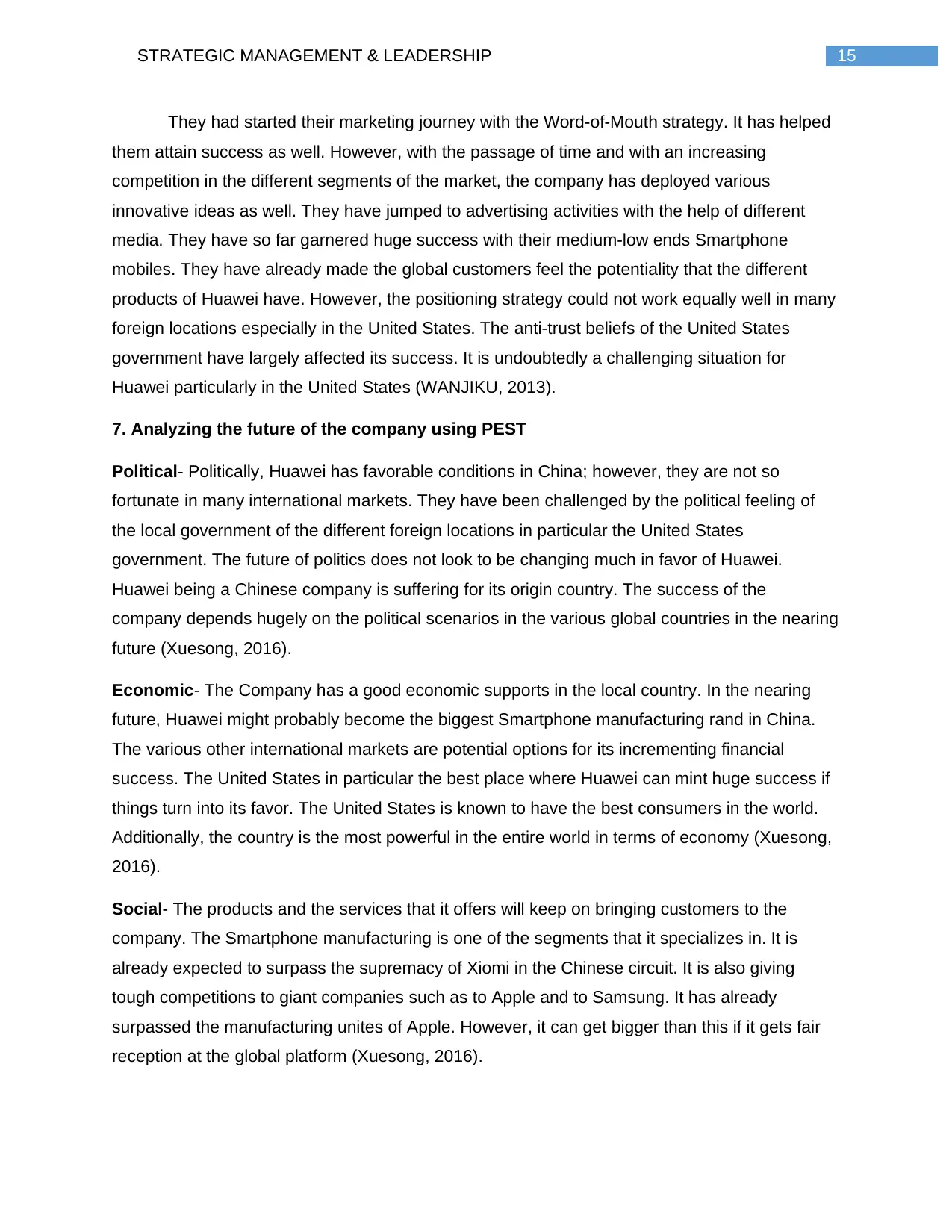
15STRATEGIC MANAGEMENT & LEADERSHIP
They had started their marketing journey with the Word-of-Mouth strategy. It has helped
them attain success as well. However, with the passage of time and with an increasing
competition in the different segments of the market, the company has deployed various
innovative ideas as well. They have jumped to advertising activities with the help of different
media. They have so far garnered huge success with their medium-low ends Smartphone
mobiles. They have already made the global customers feel the potentiality that the different
products of Huawei have. However, the positioning strategy could not work equally well in many
foreign locations especially in the United States. The anti-trust beliefs of the United States
government have largely affected its success. It is undoubtedly a challenging situation for
Huawei particularly in the United States (WANJIKU, 2013).
7. Analyzing the future of the company using PEST
Political- Politically, Huawei has favorable conditions in China; however, they are not so
fortunate in many international markets. They have been challenged by the political feeling of
the local government of the different foreign locations in particular the United States
government. The future of politics does not look to be changing much in favor of Huawei.
Huawei being a Chinese company is suffering for its origin country. The success of the
company depends hugely on the political scenarios in the various global countries in the nearing
future (Xuesong, 2016).
Economic- The Company has a good economic supports in the local country. In the nearing
future, Huawei might probably become the biggest Smartphone manufacturing rand in China.
The various other international markets are potential options for its incrementing financial
success. The United States in particular the best place where Huawei can mint huge success if
things turn into its favor. The United States is known to have the best consumers in the world.
Additionally, the country is the most powerful in the entire world in terms of economy (Xuesong,
2016).
Social- The products and the services that it offers will keep on bringing customers to the
company. The Smartphone manufacturing is one of the segments that it specializes in. It is
already expected to surpass the supremacy of Xiomi in the Chinese circuit. It is also giving
tough competitions to giant companies such as to Apple and to Samsung. It has already
surpassed the manufacturing unites of Apple. However, it can get bigger than this if it gets fair
reception at the global platform (Xuesong, 2016).
They had started their marketing journey with the Word-of-Mouth strategy. It has helped
them attain success as well. However, with the passage of time and with an increasing
competition in the different segments of the market, the company has deployed various
innovative ideas as well. They have jumped to advertising activities with the help of different
media. They have so far garnered huge success with their medium-low ends Smartphone
mobiles. They have already made the global customers feel the potentiality that the different
products of Huawei have. However, the positioning strategy could not work equally well in many
foreign locations especially in the United States. The anti-trust beliefs of the United States
government have largely affected its success. It is undoubtedly a challenging situation for
Huawei particularly in the United States (WANJIKU, 2013).
7. Analyzing the future of the company using PEST
Political- Politically, Huawei has favorable conditions in China; however, they are not so
fortunate in many international markets. They have been challenged by the political feeling of
the local government of the different foreign locations in particular the United States
government. The future of politics does not look to be changing much in favor of Huawei.
Huawei being a Chinese company is suffering for its origin country. The success of the
company depends hugely on the political scenarios in the various global countries in the nearing
future (Xuesong, 2016).
Economic- The Company has a good economic supports in the local country. In the nearing
future, Huawei might probably become the biggest Smartphone manufacturing rand in China.
The various other international markets are potential options for its incrementing financial
success. The United States in particular the best place where Huawei can mint huge success if
things turn into its favor. The United States is known to have the best consumers in the world.
Additionally, the country is the most powerful in the entire world in terms of economy (Xuesong,
2016).
Social- The products and the services that it offers will keep on bringing customers to the
company. The Smartphone manufacturing is one of the segments that it specializes in. It is
already expected to surpass the supremacy of Xiomi in the Chinese circuit. It is also giving
tough competitions to giant companies such as to Apple and to Samsung. It has already
surpassed the manufacturing unites of Apple. However, it can get bigger than this if it gets fair
reception at the global platform (Xuesong, 2016).
Secure Best Marks with AI Grader
Need help grading? Try our AI Grader for instant feedback on your assignments.
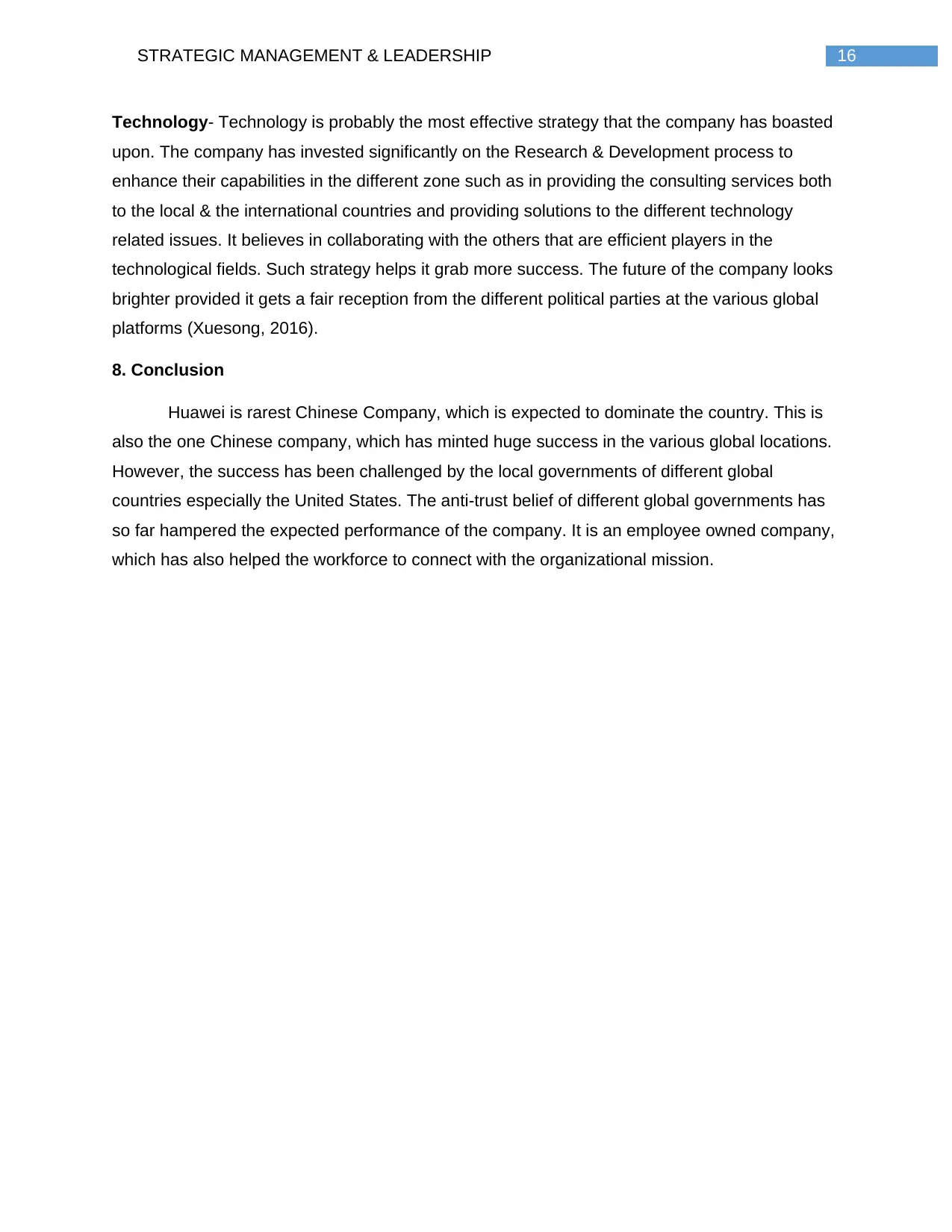
16STRATEGIC MANAGEMENT & LEADERSHIP
Technology- Technology is probably the most effective strategy that the company has boasted
upon. The company has invested significantly on the Research & Development process to
enhance their capabilities in the different zone such as in providing the consulting services both
to the local & the international countries and providing solutions to the different technology
related issues. It believes in collaborating with the others that are efficient players in the
technological fields. Such strategy helps it grab more success. The future of the company looks
brighter provided it gets a fair reception from the different political parties at the various global
platforms (Xuesong, 2016).
8. Conclusion
Huawei is rarest Chinese Company, which is expected to dominate the country. This is
also the one Chinese company, which has minted huge success in the various global locations.
However, the success has been challenged by the local governments of different global
countries especially the United States. The anti-trust belief of different global governments has
so far hampered the expected performance of the company. It is an employee owned company,
which has also helped the workforce to connect with the organizational mission.
Technology- Technology is probably the most effective strategy that the company has boasted
upon. The company has invested significantly on the Research & Development process to
enhance their capabilities in the different zone such as in providing the consulting services both
to the local & the international countries and providing solutions to the different technology
related issues. It believes in collaborating with the others that are efficient players in the
technological fields. Such strategy helps it grab more success. The future of the company looks
brighter provided it gets a fair reception from the different political parties at the various global
platforms (Xuesong, 2016).
8. Conclusion
Huawei is rarest Chinese Company, which is expected to dominate the country. This is
also the one Chinese company, which has minted huge success in the various global locations.
However, the success has been challenged by the local governments of different global
countries especially the United States. The anti-trust belief of different global governments has
so far hampered the expected performance of the company. It is an employee owned company,
which has also helped the workforce to connect with the organizational mission.
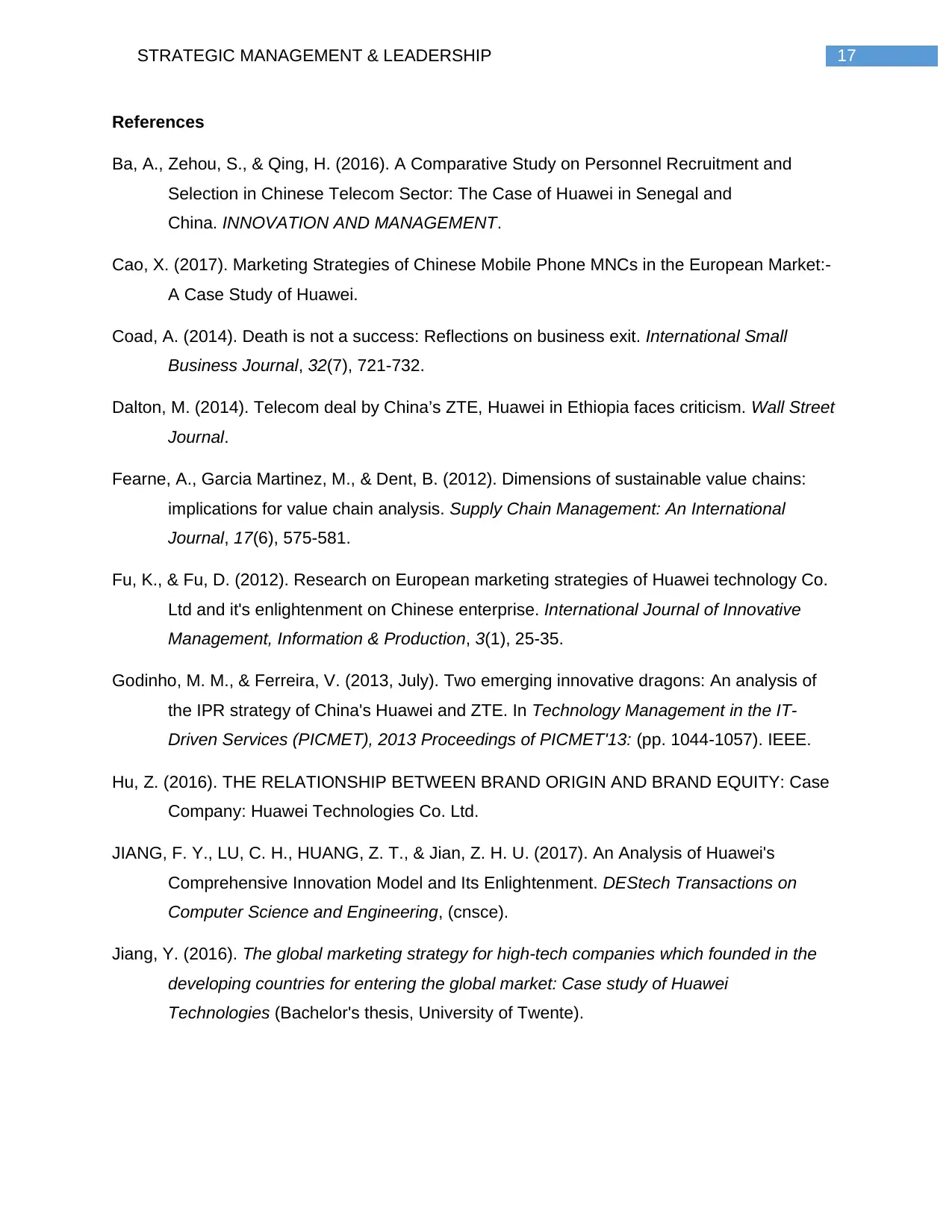
17STRATEGIC MANAGEMENT & LEADERSHIP
References
Ba, A., Zehou, S., & Qing, H. (2016). A Comparative Study on Personnel Recruitment and
Selection in Chinese Telecom Sector: The Case of Huawei in Senegal and
China. INNOVATION AND MANAGEMENT.
Cao, X. (2017). Marketing Strategies of Chinese Mobile Phone MNCs in the European Market:-
A Case Study of Huawei.
Coad, A. (2014). Death is not a success: Reflections on business exit. International Small
Business Journal, 32(7), 721-732.
Dalton, M. (2014). Telecom deal by China’s ZTE, Huawei in Ethiopia faces criticism. Wall Street
Journal.
Fearne, A., Garcia Martinez, M., & Dent, B. (2012). Dimensions of sustainable value chains:
implications for value chain analysis. Supply Chain Management: An International
Journal, 17(6), 575-581.
Fu, K., & Fu, D. (2012). Research on European marketing strategies of Huawei technology Co.
Ltd and it's enlightenment on Chinese enterprise. International Journal of Innovative
Management, Information & Production, 3(1), 25-35.
Godinho, M. M., & Ferreira, V. (2013, July). Two emerging innovative dragons: An analysis of
the IPR strategy of China's Huawei and ZTE. In Technology Management in the IT-
Driven Services (PICMET), 2013 Proceedings of PICMET'13: (pp. 1044-1057). IEEE.
Hu, Z. (2016). THE RELATIONSHIP BETWEEN BRAND ORIGIN AND BRAND EQUITY: Case
Company: Huawei Technologies Co. Ltd.
JIANG, F. Y., LU, C. H., HUANG, Z. T., & Jian, Z. H. U. (2017). An Analysis of Huawei's
Comprehensive Innovation Model and Its Enlightenment. DEStech Transactions on
Computer Science and Engineering, (cnsce).
Jiang, Y. (2016). The global marketing strategy for high-tech companies which founded in the
developing countries for entering the global market: Case study of Huawei
Technologies (Bachelor's thesis, University of Twente).
References
Ba, A., Zehou, S., & Qing, H. (2016). A Comparative Study on Personnel Recruitment and
Selection in Chinese Telecom Sector: The Case of Huawei in Senegal and
China. INNOVATION AND MANAGEMENT.
Cao, X. (2017). Marketing Strategies of Chinese Mobile Phone MNCs in the European Market:-
A Case Study of Huawei.
Coad, A. (2014). Death is not a success: Reflections on business exit. International Small
Business Journal, 32(7), 721-732.
Dalton, M. (2014). Telecom deal by China’s ZTE, Huawei in Ethiopia faces criticism. Wall Street
Journal.
Fearne, A., Garcia Martinez, M., & Dent, B. (2012). Dimensions of sustainable value chains:
implications for value chain analysis. Supply Chain Management: An International
Journal, 17(6), 575-581.
Fu, K., & Fu, D. (2012). Research on European marketing strategies of Huawei technology Co.
Ltd and it's enlightenment on Chinese enterprise. International Journal of Innovative
Management, Information & Production, 3(1), 25-35.
Godinho, M. M., & Ferreira, V. (2013, July). Two emerging innovative dragons: An analysis of
the IPR strategy of China's Huawei and ZTE. In Technology Management in the IT-
Driven Services (PICMET), 2013 Proceedings of PICMET'13: (pp. 1044-1057). IEEE.
Hu, Z. (2016). THE RELATIONSHIP BETWEEN BRAND ORIGIN AND BRAND EQUITY: Case
Company: Huawei Technologies Co. Ltd.
JIANG, F. Y., LU, C. H., HUANG, Z. T., & Jian, Z. H. U. (2017). An Analysis of Huawei's
Comprehensive Innovation Model and Its Enlightenment. DEStech Transactions on
Computer Science and Engineering, (cnsce).
Jiang, Y. (2016). The global marketing strategy for high-tech companies which founded in the
developing countries for entering the global market: Case study of Huawei
Technologies (Bachelor's thesis, University of Twente).
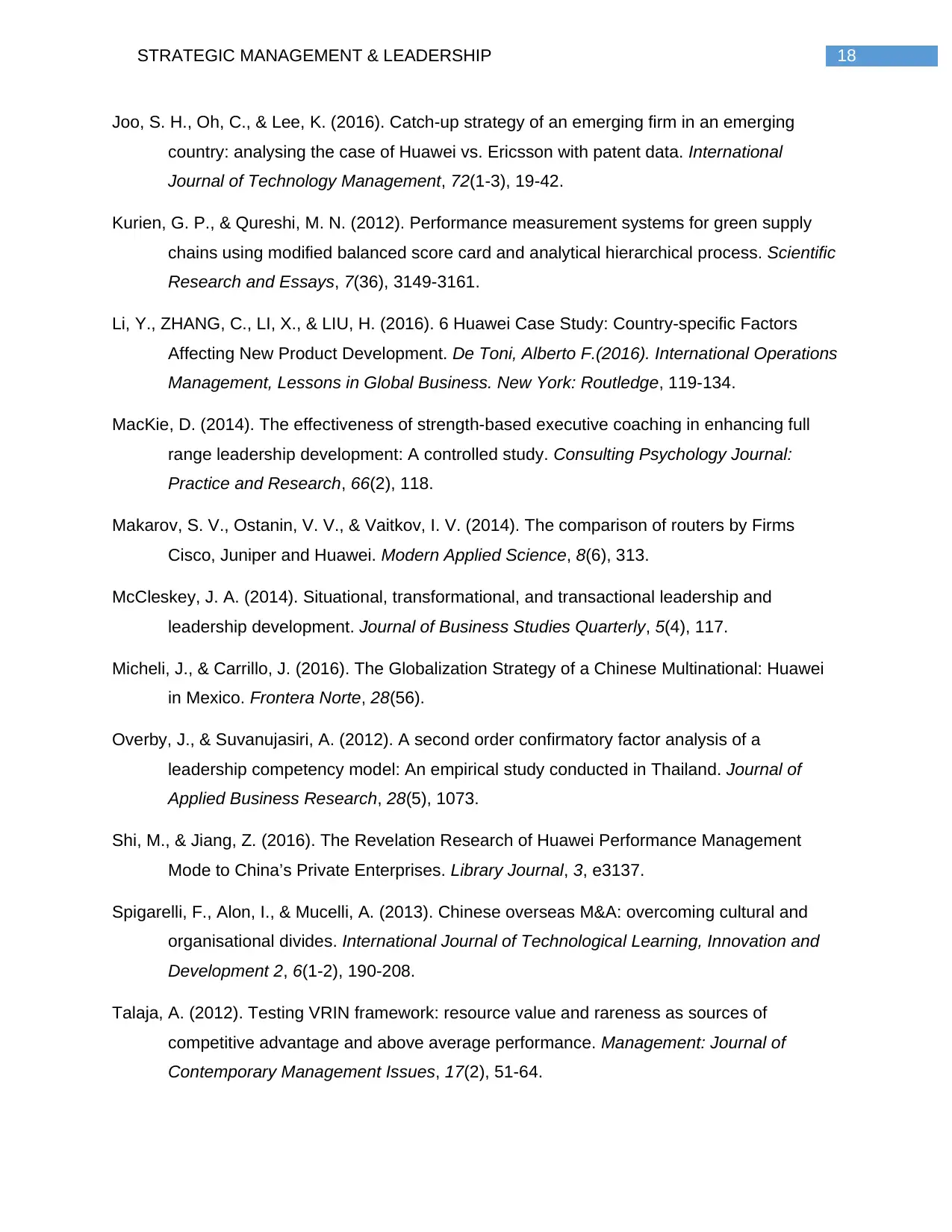
18STRATEGIC MANAGEMENT & LEADERSHIP
Joo, S. H., Oh, C., & Lee, K. (2016). Catch-up strategy of an emerging firm in an emerging
country: analysing the case of Huawei vs. Ericsson with patent data. International
Journal of Technology Management, 72(1-3), 19-42.
Kurien, G. P., & Qureshi, M. N. (2012). Performance measurement systems for green supply
chains using modified balanced score card and analytical hierarchical process. Scientific
Research and Essays, 7(36), 3149-3161.
Li, Y., ZHANG, C., LI, X., & LIU, H. (2016). 6 Huawei Case Study: Country-specific Factors
Affecting New Product Development. De Toni, Alberto F.(2016). International Operations
Management, Lessons in Global Business. New York: Routledge, 119-134.
MacKie, D. (2014). The effectiveness of strength-based executive coaching in enhancing full
range leadership development: A controlled study. Consulting Psychology Journal:
Practice and Research, 66(2), 118.
Makarov, S. V., Ostanin, V. V., & Vaitkov, I. V. (2014). The comparison of routers by Firms
Cisco, Juniper and Huawei. Modern Applied Science, 8(6), 313.
McCleskey, J. A. (2014). Situational, transformational, and transactional leadership and
leadership development. Journal of Business Studies Quarterly, 5(4), 117.
Micheli, J., & Carrillo, J. (2016). The Globalization Strategy of a Chinese Multinational: Huawei
in Mexico. Frontera Norte, 28(56).
Overby, J., & Suvanujasiri, A. (2012). A second order confirmatory factor analysis of a
leadership competency model: An empirical study conducted in Thailand. Journal of
Applied Business Research, 28(5), 1073.
Shi, M., & Jiang, Z. (2016). The Revelation Research of Huawei Performance Management
Mode to China’s Private Enterprises. Library Journal, 3, e3137.
Spigarelli, F., Alon, I., & Mucelli, A. (2013). Chinese overseas M&A: overcoming cultural and
organisational divides. International Journal of Technological Learning, Innovation and
Development 2, 6(1-2), 190-208.
Talaja, A. (2012). Testing VRIN framework: resource value and rareness as sources of
competitive advantage and above average performance. Management: Journal of
Contemporary Management Issues, 17(2), 51-64.
Joo, S. H., Oh, C., & Lee, K. (2016). Catch-up strategy of an emerging firm in an emerging
country: analysing the case of Huawei vs. Ericsson with patent data. International
Journal of Technology Management, 72(1-3), 19-42.
Kurien, G. P., & Qureshi, M. N. (2012). Performance measurement systems for green supply
chains using modified balanced score card and analytical hierarchical process. Scientific
Research and Essays, 7(36), 3149-3161.
Li, Y., ZHANG, C., LI, X., & LIU, H. (2016). 6 Huawei Case Study: Country-specific Factors
Affecting New Product Development. De Toni, Alberto F.(2016). International Operations
Management, Lessons in Global Business. New York: Routledge, 119-134.
MacKie, D. (2014). The effectiveness of strength-based executive coaching in enhancing full
range leadership development: A controlled study. Consulting Psychology Journal:
Practice and Research, 66(2), 118.
Makarov, S. V., Ostanin, V. V., & Vaitkov, I. V. (2014). The comparison of routers by Firms
Cisco, Juniper and Huawei. Modern Applied Science, 8(6), 313.
McCleskey, J. A. (2014). Situational, transformational, and transactional leadership and
leadership development. Journal of Business Studies Quarterly, 5(4), 117.
Micheli, J., & Carrillo, J. (2016). The Globalization Strategy of a Chinese Multinational: Huawei
in Mexico. Frontera Norte, 28(56).
Overby, J., & Suvanujasiri, A. (2012). A second order confirmatory factor analysis of a
leadership competency model: An empirical study conducted in Thailand. Journal of
Applied Business Research, 28(5), 1073.
Shi, M., & Jiang, Z. (2016). The Revelation Research of Huawei Performance Management
Mode to China’s Private Enterprises. Library Journal, 3, e3137.
Spigarelli, F., Alon, I., & Mucelli, A. (2013). Chinese overseas M&A: overcoming cultural and
organisational divides. International Journal of Technological Learning, Innovation and
Development 2, 6(1-2), 190-208.
Talaja, A. (2012). Testing VRIN framework: resource value and rareness as sources of
competitive advantage and above average performance. Management: Journal of
Contemporary Management Issues, 17(2), 51-64.
Paraphrase This Document
Need a fresh take? Get an instant paraphrase of this document with our AI Paraphraser
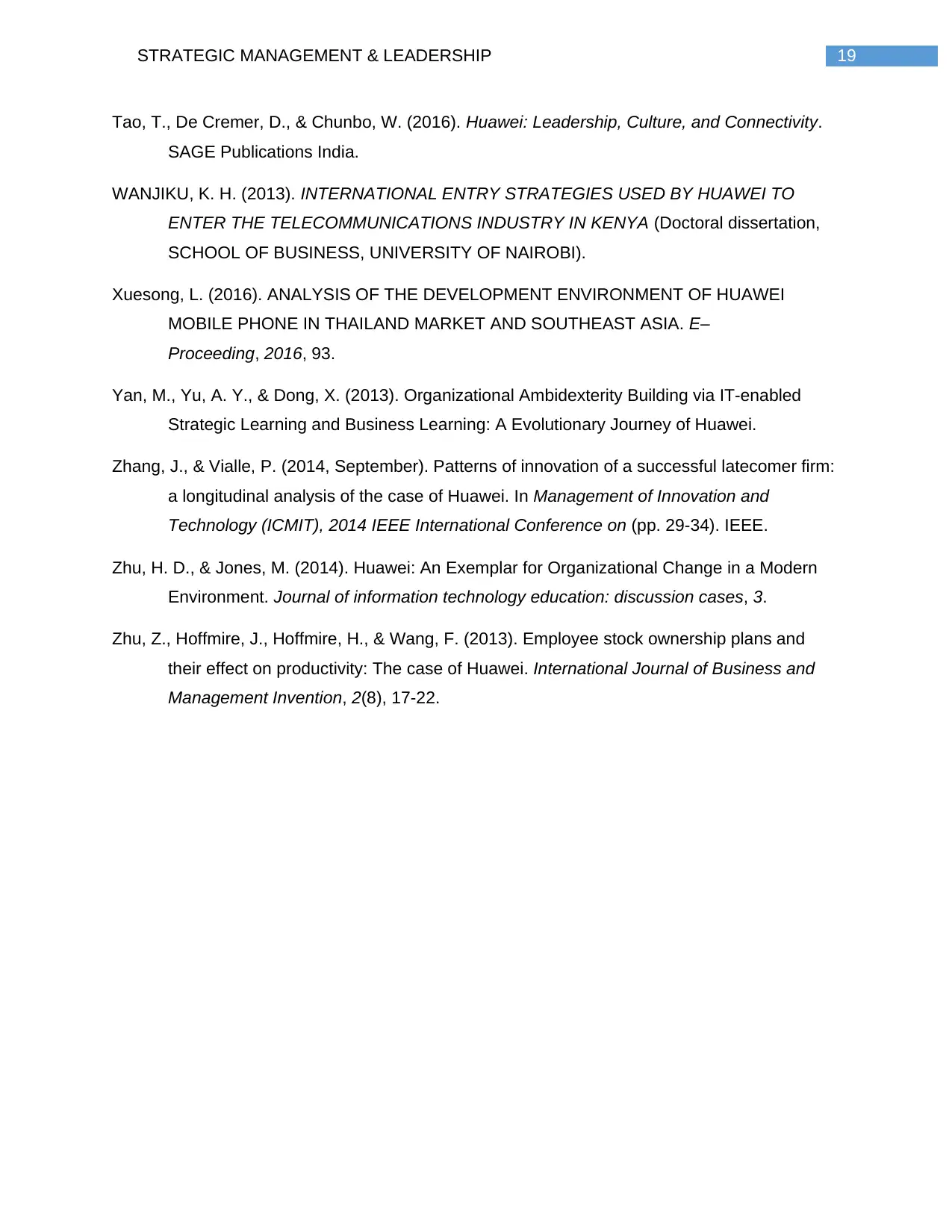
19STRATEGIC MANAGEMENT & LEADERSHIP
Tao, T., De Cremer, D., & Chunbo, W. (2016). Huawei: Leadership, Culture, and Connectivity.
SAGE Publications India.
WANJIKU, K. H. (2013). INTERNATIONAL ENTRY STRATEGIES USED BY HUAWEI TO
ENTER THE TELECOMMUNICATIONS INDUSTRY IN KENYA (Doctoral dissertation,
SCHOOL OF BUSINESS, UNIVERSITY OF NAIROBI).
Xuesong, L. (2016). ANALYSIS OF THE DEVELOPMENT ENVIRONMENT OF HUAWEI
MOBILE PHONE IN THAILAND MARKET AND SOUTHEAST ASIA. E–
Proceeding, 2016, 93.
Yan, M., Yu, A. Y., & Dong, X. (2013). Organizational Ambidexterity Building via IT-enabled
Strategic Learning and Business Learning: A Evolutionary Journey of Huawei.
Zhang, J., & Vialle, P. (2014, September). Patterns of innovation of a successful latecomer firm:
a longitudinal analysis of the case of Huawei. In Management of Innovation and
Technology (ICMIT), 2014 IEEE International Conference on (pp. 29-34). IEEE.
Zhu, H. D., & Jones, M. (2014). Huawei: An Exemplar for Organizational Change in a Modern
Environment. Journal of information technology education: discussion cases, 3.
Zhu, Z., Hoffmire, J., Hoffmire, H., & Wang, F. (2013). Employee stock ownership plans and
their effect on productivity: The case of Huawei. International Journal of Business and
Management Invention, 2(8), 17-22.
Tao, T., De Cremer, D., & Chunbo, W. (2016). Huawei: Leadership, Culture, and Connectivity.
SAGE Publications India.
WANJIKU, K. H. (2013). INTERNATIONAL ENTRY STRATEGIES USED BY HUAWEI TO
ENTER THE TELECOMMUNICATIONS INDUSTRY IN KENYA (Doctoral dissertation,
SCHOOL OF BUSINESS, UNIVERSITY OF NAIROBI).
Xuesong, L. (2016). ANALYSIS OF THE DEVELOPMENT ENVIRONMENT OF HUAWEI
MOBILE PHONE IN THAILAND MARKET AND SOUTHEAST ASIA. E–
Proceeding, 2016, 93.
Yan, M., Yu, A. Y., & Dong, X. (2013). Organizational Ambidexterity Building via IT-enabled
Strategic Learning and Business Learning: A Evolutionary Journey of Huawei.
Zhang, J., & Vialle, P. (2014, September). Patterns of innovation of a successful latecomer firm:
a longitudinal analysis of the case of Huawei. In Management of Innovation and
Technology (ICMIT), 2014 IEEE International Conference on (pp. 29-34). IEEE.
Zhu, H. D., & Jones, M. (2014). Huawei: An Exemplar for Organizational Change in a Modern
Environment. Journal of information technology education: discussion cases, 3.
Zhu, Z., Hoffmire, J., Hoffmire, H., & Wang, F. (2013). Employee stock ownership plans and
their effect on productivity: The case of Huawei. International Journal of Business and
Management Invention, 2(8), 17-22.
1 out of 20
Related Documents
Your All-in-One AI-Powered Toolkit for Academic Success.
+13062052269
info@desklib.com
Available 24*7 on WhatsApp / Email
![[object Object]](/_next/static/media/star-bottom.7253800d.svg)
Unlock your academic potential
© 2024 | Zucol Services PVT LTD | All rights reserved.





